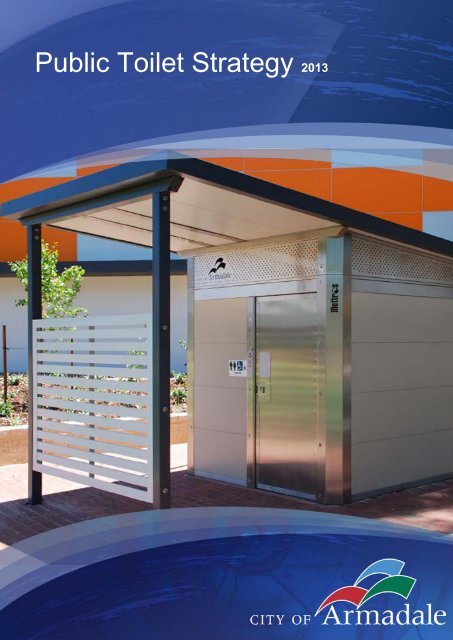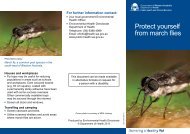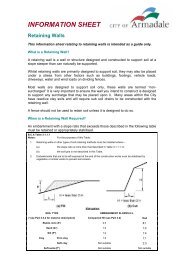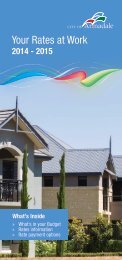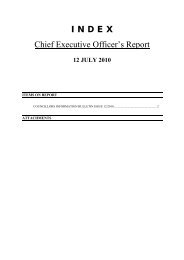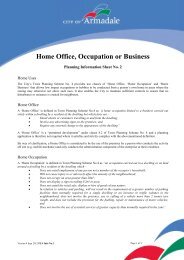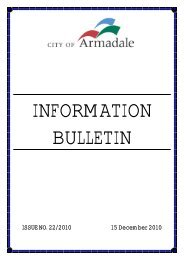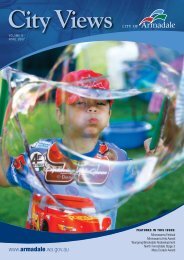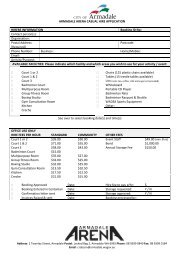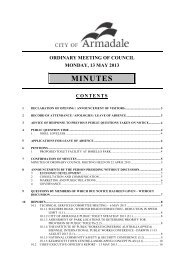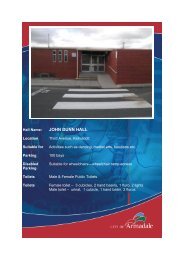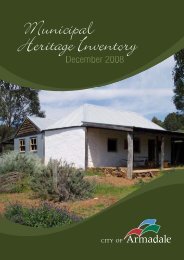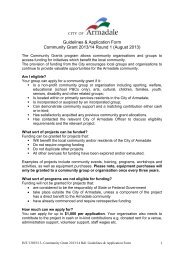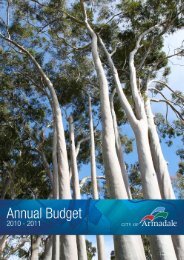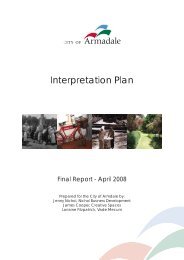Public Toilet Strategy 2013 - City of Armadale
Public Toilet Strategy 2013 - City of Armadale
Public Toilet Strategy 2013 - City of Armadale
You also want an ePaper? Increase the reach of your titles
YUMPU automatically turns print PDFs into web optimized ePapers that Google loves.
<strong>Public</strong> <strong>Toilet</strong> <strong>Strategy</strong> <strong>2013</strong>
TABLE OF CONTENTS<br />
TABLE OF CONTENTS 2<br />
EXECUTIVE SUMMARY 4<br />
1 Intent 4<br />
2 Analysis <strong>of</strong> existing conditions 4<br />
3 New public toilets 4<br />
4 Implementation 4<br />
5 Design Guidelines 5<br />
PART ONE: 6<br />
6 INTRODUCTION 6<br />
7 OUTLINE OF DOCUMENT 6<br />
8 GLOBAL PERSPECTIVE 7<br />
9 ROLE AND RESPONSIBILITY OF LOCAL GOVERNMENTS 7<br />
9.1 Mandate to provide public toilets 7<br />
9.2 Comparative Analysis 8<br />
9.2.1 <strong>City</strong> <strong>of</strong> Gosnells 8<br />
9.2.2 <strong>City</strong> <strong>of</strong> Cockburn 8<br />
9.2.3 <strong>City</strong> <strong>of</strong> Canning 8<br />
9.2.4 Shire <strong>of</strong> Kalamunda 8<br />
9.3 Range <strong>of</strong> options to deliver the service 8<br />
10 CONCLUSION 9<br />
PART TWO 10<br />
11 APPROACH 10<br />
12 AIM 10<br />
13 METHODOLOGY 10<br />
13.1 Step One: Inspection 10<br />
13.2 Step Two: Assessment 11<br />
13.3 Step Three: Report 11<br />
13.4 Concurrent research 11<br />
PART THREE 12<br />
14 REVIEW OF PUBLIC TOILETS WITHIN THE CITY OF ARMADALE 12<br />
14.1 <strong>Public</strong> toilets not owned by the <strong>City</strong> 12<br />
14.2 History <strong>of</strong> public toilet provision by the <strong>City</strong> <strong>of</strong> <strong>Armadale</strong> 12<br />
14.3 Review <strong>of</strong> the <strong>City</strong>’s public toilet facilities 13<br />
Page 2
14.3.1 <strong>Armadale</strong> Arena 14<br />
14.3.2 <strong>Armadale</strong> Town Hall 15<br />
14.3.3 <strong>Armadale</strong> <strong>City</strong> Council 16<br />
14.3.4 Champion Lakes Recreation Park 17<br />
14.3.5 Cross Park South 18<br />
14.3.6 Frye Park 19<br />
14.3.7 Karragullen Hall 20<br />
14.3.8 Kelmscott Library 21<br />
14.3.9 Lions Park 22<br />
14.3.10 Memorial Park 23<br />
14.3.11 Minnawarra Park 24<br />
14.3.12 Rushton Park 25<br />
14.3.13 Seville Grove Library 26<br />
14.4 Summary <strong>of</strong> the <strong>City</strong>’s public toilet facilities 26<br />
15 MANAGEMENT OF EXISTING FACILITIES 28<br />
15.1 Current Investment 28<br />
15.1.1 Free Standing 28<br />
15.1.2 Shared Facilities 29<br />
15.2 Maintenance 30<br />
15.3 Cleaning 31<br />
15.4 Opening and closing 32<br />
16 TOURISM 32<br />
17 TOILET PROVISION FOR EVENTS 32<br />
PART FOUR 34<br />
18 STRATEGIC CHOICES 34<br />
18.1 Stage One – The <strong>City</strong>’s current Strategic Direction 34<br />
18.2 Stage Two – Existing studies and decisions 34<br />
18.3 Stage Three – The Parks and Reserves hierarchy. 34<br />
18.4 Stage Four – Site-specific information 35<br />
18.4.1 Establishment Criteria: 35<br />
18.4.2 Disestablishment Criteria: 35<br />
18.5 Stage Five - Available Funding and Resources 36<br />
19 IMPLEMENTATION OF THE STRATEGY 37<br />
19.1 Existing Parks and Reserves 37<br />
20 Recommendations 38<br />
20.1 Recommendations: Development <strong>of</strong> new facilities or destinations 38<br />
20.1.1 Sporting Reserves 38<br />
20.1.2 Prioritisation <strong>of</strong> new facilities 38<br />
20.1.3 General Recommendations: Provision <strong>of</strong> new facilities 38<br />
20.2 Recommendations: Improvement <strong>of</strong> existing public toilet facilities 38<br />
20.3 General Recommendations: Improvement <strong>of</strong> existing toilet provision 40<br />
21 CONCLUSION 40<br />
APPENDIX 1 – DESIGN GUIDELINES 41<br />
ATTACHMENTS:<br />
1. <strong>City</strong> <strong>of</strong> <strong>Armadale</strong> <strong>Public</strong> <strong>Toilet</strong> Map<br />
2. <strong>Toilet</strong>s in <strong>Armadale</strong> <strong>City</strong> Centre<br />
3. Criteria determining demand for public toilet at a certain location<br />
Page 3
EXECUTIVE SUMMARY<br />
1 INTENT<br />
The lack <strong>of</strong> compulsion <strong>of</strong> local authorities to provide public toilets has led to a high level <strong>of</strong> variability <strong>of</strong><br />
standards and availability <strong>of</strong> public toilets across Australia. Although the <strong>City</strong> has no legislative responsibility<br />
to provide public toilets, the <strong>City</strong> <strong>of</strong> <strong>Armadale</strong> has formulated The <strong>City</strong> <strong>of</strong> <strong>Armadale</strong> <strong>Public</strong> <strong>Toilet</strong> <strong>Strategy</strong><br />
(referred to as “the <strong>Strategy</strong>”) in the context <strong>of</strong> creating pleasant public amenities and regards these as an<br />
investment to support economic growth in activity centres. The <strong>City</strong> <strong>of</strong> <strong>Armadale</strong> will endeavour to provide<br />
public toilets at strategic locations and will provide alternatives to prevent public toilets from becoming<br />
havens for anti-social behaviour and crime. The <strong>Strategy</strong> provide Council with a 15 year strategy for the<br />
upgrade, replacement or the possible removal <strong>of</strong> existing public toilets that do not meet the relevant current<br />
standards – for inclusion in the Strategic Community Plan and 15 year Financial Plan.<br />
2 ANALYSIS OF EXISTING CONDITIONS<br />
The <strong>Strategy</strong> provides an analysis <strong>of</strong> the thirteen public toilets across the <strong>City</strong>: seven stand-alone types and<br />
six which are incorporated within other community facilities. The toilets vary from the traditional layout <strong>of</strong><br />
1938 to a new fully automated toilet provided during 2011. Council provides toilets in many other buildings,<br />
but where the toilet is confined to staff or patrons <strong>of</strong> the facility only, they are not defined as public toilets<br />
for the purpose <strong>of</strong> this strategy. Guided by an analysis <strong>of</strong> each facility, the <strong>Strategy</strong> makes various<br />
recommendations regarding renovation, relocation or removal <strong>of</strong> the existing facilities. (Refer to Part 4,<br />
Figure 10).<br />
3 NEW PUBLIC TOILETS<br />
The <strong>Strategy</strong> also recommends the prioritisation <strong>of</strong> locations for the provision <strong>of</strong> new public toilet facilities<br />
within the <strong>City</strong> and provides a rational assessment for future provision <strong>of</strong> public toilets. The following staged<br />
decision-making process is recommended for use regarding proposed public toilet facilities:<br />
Stage One take cognisance <strong>of</strong> the <strong>City</strong>’s current Strategic Community Plan;<br />
Stage Two evaluate existing studies and decisions;<br />
Stage Three gives consideration to the <strong>City</strong>’s Parks and Reserves hierarchy;<br />
Stage Four consider site-specific information, using a proposed assessment tool (Attachment 3); and<br />
Stage Five evaluate funding/resources in terms <strong>of</strong> the 15 year plan.<br />
4 IMPLEMENTATION<br />
The <strong>Strategy</strong> proposes several recommendations to be taken into account over the next 15 years to improve<br />
the performance <strong>of</strong> <strong>Armadale</strong>’s public toilets by ensuring better accessibility, greater safety for users and to<br />
lift the perception <strong>of</strong> <strong>Armadale</strong>’s existing and future public toilets as being clean and conveniently located.<br />
(Refer to no. 20 – Recommendations)<br />
Page 4
5 DESIGN GUIDELINES<br />
To conclude, the <strong>Strategy</strong> provides design guidelines and criteria, incorporating crime prevention through<br />
environmental design (CPTED) principles, which should be considered for the provision, upgrading and siting<br />
<strong>of</strong> all future public toilet facilities to align to the recommendations <strong>of</strong> the <strong>Strategy</strong> (refer to Appendix 1)<br />
Page 5
PART ONE:<br />
6 INTRODUCTION<br />
<strong>Public</strong> toilets are a necessity for anyone who wants access to pleasant public spaces. Access to good quality<br />
public toilets is something that we should all value – not just in terms <strong>of</strong> public health and sanitation, but<br />
because they help to create attractive, inclusive and welcoming places. The business case for investment in<br />
good toilet provision has been shown to increase retail turnover, tourist numbers, and economic growth.<br />
“You cannot cost PT’s simply on what the loo paper and bricks might end up costing, you have got to see it<br />
as part <strong>of</strong> a broader context <strong>of</strong> a neighbourhood that is supporting and enabling its members to take part<br />
and get out and about.” 1<br />
In the past public toilets were designed to be out <strong>of</strong> public view, <strong>of</strong>ten without forethought for safety,<br />
aesthetic or accessibility concerns. With the changing requirements from today’s community, however, toilet<br />
facilities are now required to fulfil greater expectations <strong>of</strong> the public … to be modern, well appointed, light<br />
filled, close to focal activities, clean and functioning properly, and most importantly, located with clear and<br />
open sight lines so that people <strong>of</strong> all ages and physical abilities can use them without encountering<br />
threatening or anti-social behaviour. <strong>Public</strong> toilets are even more important to certain sections <strong>of</strong> our<br />
society, including older people, disabled people, women, families with young children and tourists.<br />
The <strong>City</strong> <strong>of</strong> <strong>Armadale</strong> therefore has to be responsive to a range <strong>of</strong> current issues in order to fulfil these<br />
expectations and demands and to provide alternatives to prevent public toilets from becoming havens for<br />
anti-social behaviour and crime.<br />
7 OUTLINE OF DOCUMENT<br />
This document is divided into four parts:<br />
Part One provides the context by investigating a global perspective on public toilets and the function,<br />
roles and responsibilities <strong>of</strong> Western Australian local governments pertaining to public toilets.<br />
Part Two will describe the approach, aims and methodology followed to draft a public toilet strategy for<br />
the <strong>City</strong> <strong>of</strong> <strong>Armadale</strong>.<br />
Part Three will provide an overview <strong>of</strong> the existing situation and issues pertaining to public toilet<br />
facilities, management and maintenance in the <strong>City</strong> <strong>of</strong> <strong>Armadale</strong>. This part includes an analysis <strong>of</strong> the<br />
potential resources on the <strong>City</strong> <strong>of</strong> <strong>Armadale</strong> Asset Register.<br />
Part Four will discuss strategic choices in terms <strong>of</strong> future decisions and provide the implementation plan<br />
in terms <strong>of</strong> recommendations regarding establishment and disestablishment <strong>of</strong> existing public toilet<br />
facilities and recommendations in general.<br />
1 Pamela Holmes, Head <strong>of</strong> charity organisation “Help the Aged”<br />
Page 6
8 GLOBAL PERSPECTIVE<br />
Automated <strong>Public</strong> <strong>Toilet</strong>s have become popular around the world as they promote sanitation (perceived<br />
cleanliness because <strong>of</strong> hands-free operation) and hard fixtures are designed to minimise vandalism. Research<br />
and development has created a range <strong>of</strong> automated toilet suppliers and products that are valued for their<br />
ease <strong>of</strong> maintenance and code compliance.<br />
“Automated toilets have been common fixtures on European sidewalks for decades. But they have been less<br />
popular in American cities, where concerns including their appearance cleanliness and tendency to attract<br />
illegal activity have slowed their installation. In Seattle, problems arose almost immediately. Users left so<br />
much trash behind that the automated floor scrubbers had to be disabled, and prostitutes and drug users<br />
found privacy behind the toilets’ locked doors.<br />
Seattle <strong>of</strong>ficials say the project here failed because the toilets, which are to close on Aug. 1, were placed in<br />
neighbourhoods that already had many drug users and transients.<br />
Rather than automated toilets, some cities are looking for cheaper alternatives that would be cleaned by<br />
human attendants.” 2<br />
“Although they are not the cause <strong>of</strong> problems in the neighbourhood, they are contributing to problems.<br />
They give people a place to hide out, to duck out <strong>of</strong> sight.” 3<br />
However, in Europe and many other countries throughout the world, the APT concept has been<br />
acknowledged as addressing issues such as vandalism, security and environmental impact.<br />
It is more likely nowadays to believe that no unsupervised installation can prevent vandalism. Even with the<br />
most vandal resistant appliances, an unsupervised facility will eventually become sub-standard.<br />
Over the last 20 years, designers and architects worldwide have begun to see the need to plan and build<br />
public toilets with the real or potential threat <strong>of</strong> crime in mind and to incorporate Crime Prevention Through<br />
Environmental Design (CPTED) principles (see Appendix 1) in the original design phase <strong>of</strong> all public toilets.<br />
It is also part <strong>of</strong> the Australian <strong>Toilet</strong> Organisation’s (ATO’s) vision to create public pride in public toilets,<br />
thereby creating local guardianship <strong>of</strong> public toilets. Their main goal, locally, is to transform the public’s<br />
expectations <strong>of</strong> and relationship to public toilets by raising awareness about issues and providing solutions.<br />
9 ROLE AND RESPONSIBILITY OF LOCAL GOVERNMENTS<br />
9.1 Mandate to provide public toilets<br />
Times have changed, as have the pressures and duties on local authorities. While much <strong>of</strong> the new provision<br />
is on a smaller scale than that it replaces, there are many instances <strong>of</strong> the total withdrawal <strong>of</strong> toilet facilities.<br />
The lack <strong>of</strong> compulsion <strong>of</strong> local authorities to provide public toilets, together with a perception <strong>of</strong> nuisance<br />
associate with them, has arguably resulted in a steady decline in the provision <strong>of</strong> public toilets in recent<br />
years. What was an essential service is now a desirable, discretionary and non-statutory function that<br />
competes for finite resources.<br />
Although the <strong>City</strong> has no legislative responsibility to provide public toilets other than those associated with<br />
building regulations for the stock <strong>of</strong> Council owned public buildings, they have shown to improve local<br />
amenity and support active participation in recreational, social and commercial activity within the <strong>City</strong> for<br />
visitors and residents alike.<br />
2 Christopher Maag, The New York Times, 17 July 2008<br />
3 Seattle (Washington, USA) <strong>City</strong> Council member, Sally Clark, at a news conference, March 2008<br />
Page 7
9.2 Comparative Analysis<br />
The <strong>City</strong> <strong>of</strong> <strong>Armadale</strong>’s peer group/neighbouring Council’s policies/practices have also been reviewed in<br />
order to establish key trends and best practice for specific aspects <strong>of</strong> public toilet provision. For the purposes<br />
<strong>of</strong> this report, the peer council group comprised <strong>City</strong> <strong>of</strong> Gosnells, <strong>City</strong> <strong>of</strong> Cockburn, <strong>City</strong> <strong>of</strong> Canning and Shire<br />
<strong>of</strong> Kalamunda.<br />
9.2.1 <strong>City</strong> <strong>of</strong> Gosnells<br />
The <strong>City</strong> <strong>of</strong> Gosnells does not have a <strong>Public</strong> <strong>Toilet</strong> <strong>Strategy</strong> for their 13 (approx.) public toilets <strong>of</strong> which one is<br />
a composting type located in the hills area, which exudes a pungent odour and another that is fully<br />
automated. The latter incurs high maintenance costs given that specialist repairers are required, not a<br />
standard plumber. Currently the <strong>City</strong> is changing over to lightless, windowless, stainless steel, and seat less<br />
systems with the cistern placed in ducts and the toilet roll holders in locked containers. Most toilets are<br />
cleaned and inspected daily except those in high use areas, which may be cleaned twice a day. All external<br />
doors are protected by security cages. The measures the <strong>City</strong> has adopted has restricted vandalism to a<br />
“limited” status.<br />
9.2.2 <strong>City</strong> <strong>of</strong> Cockburn<br />
The <strong>City</strong> <strong>of</strong> Cockburn does not have a <strong>Public</strong> <strong>Toilet</strong> <strong>Strategy</strong> nor do they have any automated toilets amongst<br />
their eight stand-alone public toilets. Except in vandalism “hot spots” toilets are open 24 hours per day, the<br />
excepted locations open at 6am and close at 8pm or 9.30pm winter and summer respectively. Vandalism is<br />
on average at a medium to high level. In high usage locations, stainless steel pans are preferred but<br />
traditional porcelain elsewhere.<br />
9.2.3 <strong>City</strong> <strong>of</strong> Canning<br />
The <strong>City</strong> does not have a <strong>Public</strong> <strong>Toilet</strong> <strong>Strategy</strong> for their 12 (approx.) public toilets. It has also historically<br />
avoided automated and stainless steel opting for what it feels is the more cost effective porcelain toilet pans<br />
and it will continue with its current management regime. Whilst there are some “hot spots” concerning<br />
vandalism, in the main such is at a manageable level.<br />
9.2.4 Shire <strong>of</strong> Kalamunda<br />
The Shire does not have a <strong>Public</strong> <strong>Toilet</strong> <strong>Strategy</strong> nor do they have any toilet amongst their twelve standalone,<br />
traditional style public toilets which is connected to water-borne deep sewer. All public toilets are<br />
connected to conventional septic tanks with leach drains. Although three vandalism “hot spots” were<br />
identified by the Shire, the level <strong>of</strong> vandalism is considered to be average.<br />
9.3 Range <strong>of</strong> options to deliver the service<br />
How local authorities function and the cost <strong>of</strong> directly employed and/or contract services has also changed<br />
significantly. Labour is no longer a cheap asset. The base cost and on-costs <strong>of</strong> employing a toilet attendant<br />
are prohibitive, as are other labour costs, which, in some cases, outweigh the cost <strong>of</strong> the ‘seat itself’.<br />
Often a suggested solution is to charge the public, who use the facilities. However, charging for these<br />
facilities is a complex matter. There is public resistance to charging, particularly if the facilities are not then in<br />
pristine condition. In many circumstances, the cost <strong>of</strong> collecting, counting and transporting the money as<br />
well as the minor discouragement to those who would wish to misuse the facility, prove this option not to be<br />
enduring and certainly not acceptable for a service that many users already believe should be free.<br />
Another course <strong>of</strong> action for the local authorities is Community <strong>Toilet</strong> Schemes (CTS). The local government<br />
work in partnership with local businesses to provide access for the public to clean, safe toilets and may<br />
Page 8
provide a payment to participating local businesses. However, one <strong>of</strong> the terms and conditions <strong>of</strong> the CTS<br />
should state that the Service Provider/Proprietor retains the right in exceptional circumstances to refuse any<br />
member or members <strong>of</strong> the general public (e.g. large numbers needing the toilet at the same time)<br />
admission to their premises and/or use <strong>of</strong> their toilet facilities. This means that the toilets are not public in<br />
the same sense that municipal toilets are public; the scheme’s toilets are open to the public, if the service<br />
provider is prepared to accept them. In CTS schemes, it is important that the signage needs to be extremely<br />
clear and welcoming to the public. When local authorities start such a scheme, the initiative should be<br />
heavily publicised in the local media.<br />
Although successful in several councils overseas, CTS are not known to be used by any Council in Australia.<br />
10 CONCLUSION<br />
The lack <strong>of</strong> compulsion <strong>of</strong> local authorities to provide public toilets has inevitably led to a high level <strong>of</strong><br />
variability <strong>of</strong> standards and availability <strong>of</strong> public toilets across the country. Some local authorities are less<br />
committed to the maintenance or provision <strong>of</strong> public toilets, while many others – concerned about the<br />
decline in public toilet provision – seeks to stimulate discussion, to achieve better provision, to promote a<br />
positive shift in attitudes and approaches to the whole issue <strong>of</strong> toilet provision and use by formulating and<br />
adopting a strategic approach. The <strong>City</strong> <strong>of</strong> <strong>Armadale</strong> formulates this public toilet strategy in the context <strong>of</strong><br />
creating pleasant public amenities and regards it as an investment to support economic growth in activity<br />
centres. As the Americans say, “Bathrooms means business”.<br />
Page 9
PART TWO<br />
Part Two will describe the approach, aims, and methodology followed to draft a public toilet strategy for<br />
the <strong>City</strong> <strong>of</strong> <strong>Armadale</strong>.<br />
11 APPROACH<br />
In order for the <strong>City</strong> <strong>of</strong> <strong>Armadale</strong> to “maintain and improve, where required, the quality, amenity and<br />
accessibility <strong>of</strong> open spaces and to provide and maintain Council buildings, facilities and public amenities”<br />
(2010-2014 Strategic Plan); the <strong>City</strong> should consider the provision <strong>of</strong> a sustainable network <strong>of</strong> well-located<br />
public toilets that provide all users with a convenient, safe and positive experience.<br />
The approach to deliver the most appropriate network <strong>of</strong> public toilets relies on strategic objectives that take<br />
cognisance <strong>of</strong> current resources (refer to Part Three); prioritise certain spatial areas in the <strong>City</strong> <strong>of</strong> <strong>Armadale</strong><br />
(refer to Part Four) and benchmark best practice (refer to Appendix 1).<br />
This <strong>Public</strong> <strong>Toilet</strong> <strong>Strategy</strong> responds to the challenges highlighted in this report by providing a series <strong>of</strong><br />
guidelines for the construction and maintenance <strong>of</strong> public toilets within the <strong>City</strong>, with the key aims <strong>of</strong> the<br />
strategy outlined below.<br />
12 AIM<br />
The key aims <strong>of</strong> this report are to:<br />
• Provide Council with a 15 year strategy for the upgrade, replacement or the possible removal <strong>of</strong><br />
existing public toilets that do not meet the relevant current standards – for inclusion in the Strategic<br />
Community Plan and 15 year Financial Plan.<br />
• Recommend and prioritise locations for the provision <strong>of</strong> new public toilet facilities within the <strong>City</strong>;<br />
• Provide a framework for the ongoing management and upgrade <strong>of</strong> public toilets throughout the <strong>City</strong>;<br />
and<br />
• Provide design guidelines and criteria to establish standards for the provision <strong>of</strong> new and upgraded<br />
amenities.<br />
13 METHODOLOGY<br />
The process to formulate the strategy included the following stages:<br />
13.1 Step One: Inspection<br />
Each toilet has been individually inspected and its location recorded. External photographs <strong>of</strong> the toilets<br />
were taken in order to provide context (accessibility, location, design, signage); internal photographs were<br />
taken (where possible) to aid further assessment in terms <strong>of</strong> the facilities availability (condition, appearance).<br />
Page<br />
10
13.2 Step Two: Assessment<br />
Following completion <strong>of</strong> the fieldwork, a comprehensive review was undertaken in which each toilet was<br />
individually assessed against selected criteria. This process has taken into account the inputs received from<br />
key stakeholders gathered through liaison, information collection and personal communication.<br />
The following options were then assessed:<br />
• Retention <strong>of</strong> existing toilet<br />
• Upgrade/refurbishment <strong>of</strong> existing toilet<br />
• Removal and replacement <strong>of</strong> existing toilet in current location<br />
• Removal and replacement <strong>of</strong> existing toilet to alternate location<br />
• Removal <strong>of</strong> existing toilet with no replacement<br />
13.3 Step Three: Report<br />
Based on the fieldwork and research carried out in previous stages, this report has been prepared which<br />
includes a comprehensive inventory and review <strong>of</strong> existing Council-owned public toilet facilities, a review on<br />
possible locations for the provision <strong>of</strong> new toilet facilities and a recommended strategy/design guidelines for<br />
the upgrade, redesign or provision <strong>of</strong> public toilets for the next 15 years.<br />
13.4 Concurrent research<br />
Concurrent with the above two stages, research was undertaken, investigating the following:<br />
• Review - a global perspective on public toilets<br />
• Comparative analysis <strong>of</strong> local governments in the metropolitan area surrounding the <strong>City</strong> <strong>of</strong><br />
<strong>Armadale</strong><br />
• Options for establishing new toilet facilities in typically active reserves, which provide other<br />
associated amenities such as playgrounds, and barbeque facilities<br />
• Strategic decision-making process determining demand for establishment <strong>of</strong> new PT facilities<br />
• Options for co-location and public-private partnerships<br />
• Management <strong>of</strong> PT facilities – maintenance, costs<br />
• Establishing the useful lifespan <strong>of</strong> existing assets<br />
• Alternative options for public toilet provision during community events<br />
• Application <strong>of</strong> CPTED principles (see Appendix 1); and<br />
• Design guidelines for future provision <strong>of</strong> public toilets (Appendix 1)<br />
Page<br />
11
PART THREE<br />
Part Three will provide an overview <strong>of</strong> the existing public toilet facilities within the <strong>City</strong> <strong>of</strong> <strong>Armadale</strong> as<br />
well as management and maintenance by the <strong>City</strong>. This part includes an analysis <strong>of</strong> the potential<br />
resources on the <strong>City</strong> <strong>of</strong> <strong>Armadale</strong> Asset Register.<br />
14 REVIEW OF PUBLIC TOILETS WITHIN THE CITY OF ARMADALE<br />
The <strong>City</strong> <strong>of</strong> <strong>Armadale</strong> <strong>Public</strong> <strong>Toilet</strong> Map (Attachment 1) indicates the location <strong>of</strong> all public toilets within the<br />
<strong>City</strong> <strong>of</strong> <strong>Armadale</strong> which include those managed and maintained by the <strong>City</strong> as well as public toilets within the<br />
<strong>City</strong>, not owned by the <strong>City</strong>.<br />
14.1 <strong>Public</strong> toilets not owned by the <strong>City</strong><br />
The following locations, such as railway stations, shopping centres, service stations etc. are not owned or<br />
managed by the CoA, but also provide toilet facilities to the public. Location <strong>of</strong> these facilities is also<br />
indicated in blue on the CoA public toilet map (Attachment 1) as follows:<br />
14. <strong>Armadale</strong> Railway Station – PTA<br />
15. <strong>Armadale</strong> Central Shopping Centre<br />
16. <strong>Armadale</strong> <strong>City</strong> Shopping Centre<br />
17. *BP Service Station South Western Highway<br />
18. BP Service Station Albany Highway<br />
19. Champion Drive Shopping Centre<br />
20. Kelmscott Railway Station – PTA<br />
21. Roleystone Shopping Centre<br />
22. Stargate Shopping Centre, Kelmscott<br />
23. Westfield Shopping Centre<br />
24. Yule Do Service Station, Albany Hwy<br />
25. Churchman’s Brook Dam (Water Corporation)<br />
26. Wungong Dam (Water Corporation<br />
27. *Peak Service Station, Karragullen<br />
28. Petrol station Roleystone CBD<br />
29. *Caltex Service Station, Roleystone<br />
30. Kelmscott Shopping Centre<br />
31. Haynes Shopping Centre<br />
32. Caltex petrol station, Seville Grove<br />
33. Peak petrol station, Forrestdale<br />
34. Southern River Shopping Centre<br />
* These facilities are equipped with toilet facilities, but a purchase from the shop is required by<br />
customers in order to use them.<br />
14.2 History <strong>of</strong> public toilet provision by the <strong>City</strong> <strong>of</strong> <strong>Armadale</strong><br />
Most <strong>of</strong> the <strong>City</strong> <strong>of</strong> <strong>Armadale</strong>’s existing public toilets were provided between the 1960’s and the 1980’s and<br />
reflect this era in style and construction. Some toilets were intentionally designed to be out <strong>of</strong> public view,<br />
<strong>of</strong>ten without forethought for safety, aesthetic or accessibility concerns.<br />
Page<br />
12
The provision <strong>of</strong> these toilet facilities have been based mainly on historic use patterns, community demands<br />
and the development <strong>of</strong> the parks and reserves infrastructure. The approach to the provision <strong>of</strong> public toilets<br />
for the <strong>City</strong> <strong>of</strong> <strong>Armadale</strong> relied on various (and some instances rapid) changes to these use patterns and<br />
changing expectations.<br />
With the progressive residential development <strong>of</strong> the <strong>City</strong> in areas such as Harrisdale, Piara Waters,<br />
Forrestdale, Haynes and Hilbert, a significant impact on the use and popularity <strong>of</strong> recreational areas and the<br />
associated facilities, <strong>of</strong> which public toilets is one, will occur.<br />
The <strong>City</strong> is expected to be responsive to the demand, level <strong>of</strong> service, level <strong>of</strong> accessibility, environmental<br />
impacts and costs <strong>of</strong> public toilet provision.<br />
14.3 Review <strong>of</strong> the <strong>City</strong>’s public toilet facilities<br />
<strong>Armadale</strong> <strong>City</strong> Council currently manages 13 toilet facilities that are available to the public. <strong>Toilet</strong>s within the<br />
<strong>Armadale</strong> Arena and the two libraries (Kelmscott and Seville Grove) have also been included in this study, as<br />
the public regularly uses these facilities and staff working at these facilities is well aware <strong>of</strong> this trend.<br />
Council provides toilets in many other buildings than listed below, but where toilets are decommissioned or<br />
where the use <strong>of</strong> the toilet is confined to staff or patrons <strong>of</strong> the facility only, they are not defined as public<br />
toilets for the purpose <strong>of</strong> this strategy.<br />
The following public toilet facilities are currently managed and maintained by the CoA:<br />
Page<br />
13
14.3.1 <strong>Armadale</strong> Arena<br />
14.3.1.1 Type/Location<br />
These toilets are incorporated in the <strong>Armadale</strong> Arena, a significant sporting complex located within a<br />
residential area west <strong>of</strong> the <strong>Armadale</strong> <strong>City</strong> Centre. There is no other public toilet facility within 1km <strong>of</strong> this<br />
venue.<br />
14.3.1.2 Condition/Appearance<br />
Although attached to a public facility, this toilet does not provide access to facilities for the disabled people<br />
or child changing, or receptacles for sanitary towels or sharps, however the toilets are clean and bright.<br />
14.3.1.3 Safety/Anti-social behaviour<br />
The toilets are situated within the body <strong>of</strong> the complex. <strong>Public</strong> users therefore pass patrons and staff.<br />
Openings between cubicle walls and the floor minimises the possibility <strong>of</strong> using the toilets for other than<br />
their intended purpose.<br />
14.3.1.4 Level <strong>of</strong> use / Fit for purpose<br />
The main purpose <strong>of</strong> this facility is to provide toilet, shower and changing facilities for people using the<br />
various sporting facilities However, the public are not prevented from using the toilets should the need arise<br />
even though they may not be patrons <strong>of</strong> the arena at the time. Figures <strong>of</strong> public use are not available but it is<br />
suggested that such use is minimal. <strong>Toilet</strong> facilities are more than adequate for both <strong>of</strong> these purposes.<br />
Page<br />
14
14.3.2 <strong>Armadale</strong> Town Hall<br />
14.3.2.1 Type/Location<br />
This Traditional Stand Alone toilet is located in the south west corner <strong>of</strong> the car park adjacent to the<br />
<strong>Armadale</strong> Town Hall in Jull Street.<br />
14.3.2.2 Condition/Appearance<br />
Although adjacent to a public facility which contains its own toilets, this toilet does not provide disabled<br />
access, child changing, or receptacles for sanitary towels or sharps. The concrete floor and exposed<br />
brickwork <strong>of</strong> the interior creates a dull appearance.<br />
14.3.2.3 Safety/Anti-social behaviour<br />
Whilst the facility does not have any external doors and is therefore open 24 hours per day vandalism<br />
appears to be minor. Entrances are not clearly visible from the surrounding public areas such as the car park<br />
and Jull St. The building could provide places for people to hide, with users feeling unsafe, especially at<br />
night.<br />
14.3.2.4 Level <strong>of</strong> use / Fit for purpose<br />
This is an old style design which does not make provision for people with disabilities. The fittings and<br />
location <strong>of</strong> the toilet are no longer compliant with Australian standards.<br />
Specific usage figures are not available but it is suggested that given its location legitimate usage by the<br />
public would be minimal.<br />
Page<br />
15
14.3.3 <strong>Armadale</strong> <strong>City</strong> Council<br />
14.3.3.1 Type/Location<br />
This new facility, incorporated within the <strong>City</strong>’s main administration building <strong>of</strong>f the entrance foyer, is under<br />
construction and will be available for use from May <strong>2013</strong>. The facility upstairs, which services community<br />
meetings, council meetings and public events, has been reconstructed to comply with the current<br />
accessibility code (AS1429.1-2009) and can be accessed via the ramp shown on the picture above.<br />
14.3.3.2 Condition/Appearance<br />
The fit out will be modern and inclusive <strong>of</strong> a baby changing table.<br />
14.3.3.3 Safety/Anti-social behaviour<br />
Due to full-time staff at the <strong>City</strong>’s information desk and facing a publicly trafficked area, the entrance to this<br />
facility will be highly visible and therefore unlikely to be subjected to random anti-social behaviour.<br />
14.3.3.4 Level <strong>of</strong> use / Fit for purpose<br />
The facility is located in a prime position for those visiting Council’s <strong>of</strong>fices, Modern fittings and clean<br />
appearance will make this facility more than adequate and is likely to be well used.<br />
Page<br />
16
14.3.4 Champion Lakes Recreation Park<br />
14.3.4.1 Type/Location<br />
This conventional but modern, stand-alone toilet is situated at the foreshore <strong>of</strong> the Champion Lakes rowing<br />
complex , between the car park and a small park <strong>of</strong>f Henley Drive.<br />
14.3.4.2 Condition/Appearance<br />
This is a relatively new purpose built structure. A playground or barbeque facilities are not in proximity to<br />
this area <strong>of</strong> the park, therefore the toilet block does not provide for child changing. Viewed from the car<br />
park or the road there is nothing to indicate its purpose as a public toilet.<br />
14.3.4.3 Safety/Anti-social behaviour<br />
Although usually busy at weekends, this venue tends to be quiet during <strong>of</strong>fice hours with its open aspect<br />
combined with its opening and closing hours, vandalism tends to be kept to a minimum. Graffiti is<br />
occasionally found but openings between cubicle walls and the floor minimises the possibility <strong>of</strong> anti-social<br />
behaviour.<br />
14.3.4.4 Level <strong>of</strong> use / Fit for purpose<br />
A sufficient number <strong>of</strong> cubicles with modern stainless steel fittings and fixtures makes this facility more than<br />
adequate and applies with all relevant Australian Standards. It is suggested that the facility is mainly used at<br />
weekends when the public facilities associated with the park and beach area are more intensively used.<br />
Page<br />
17
14.3.5 Cross Park South<br />
14.3.5.1 Type/Location<br />
This conventional but modern stand-alone facility is located south <strong>of</strong> the Cross Park oval, replaced the older<br />
non-compliant toilet block north <strong>of</strong> the oval, which is now disestablished in terms <strong>of</strong> public use.<br />
14.3.5.2 Condition/Appearance<br />
Apart from the untiled, concrete floor, the overall appearance is clean and tidy.<br />
14.3.5.3 Safety/Anti-social behaviour<br />
Regardless <strong>of</strong> the proximity <strong>of</strong> the building to the oval and associated car park, with all entrances being highly<br />
visible, vandalism is reported on a regular basis. Openings between cubicle doors and the floor minimise the<br />
possibility to use toilets as a hiding place.<br />
14.3.5.4 Level <strong>of</strong> use / Fit for purpose<br />
Good sized cubicles with modern, stainless steel fittings - all compliant with current standards. All toilets,<br />
including disabled, are well signed but access to the disabled toilet is poor. No sharps and sanitary towel<br />
receptacles or a child changing facility are provided. Given the proximity to a recreational area the facility is<br />
well used.<br />
Page<br />
18
14.3.6 Frye Park<br />
14.3.6.1 Type/Location<br />
These pavilion type toilets are incorporated in the Frye Park clubrooms and are only available for users <strong>of</strong> the<br />
playground and park during the week. At weekends the pavilion is open for the various sporting activities<br />
which provides the users with their own facilities and are therefore also open to the general public.<br />
14.3.6.2 Condition/Appearance<br />
The white tiled walls and porcelain fittings generate a very clean and tidy overall appearance.<br />
14.3.6.3 Safety/Anti-social behaviour<br />
The toilets are part <strong>of</strong> the pavilion, but their entrances are highly visible. A high rate <strong>of</strong> vandalism was<br />
experienced after the initial opening, but subsequently reports <strong>of</strong> anti-social behaviour are rare.<br />
14.3.6.4 Level <strong>of</strong> use / Fit for purpose<br />
These toilets are located at a prime and very popular sporting facility with a well-equipped playground. The<br />
toilets are thus <strong>of</strong>ten used and provision is more than adequate.<br />
Page<br />
19
14.3.7 Karragullen Hall<br />
14.3.7.1 Type/Location<br />
This traditional, stand-alone building is adjacent to an equally old public facility, the Karragullen Hall,<br />
adjacent to the Karragullen football/cricket oval and the Lance Morgan Pavilion.<br />
14.3.7.2 Condition/Appearance<br />
Adequate toilets and hand basins, but due to the concrete floor and old style building with direct external<br />
access, the overall appearance doesn’t seem to be very clean.<br />
14.3.7.3 Safety/Anti-social behaviour<br />
This facility is mainly used by the Scouts, who lease the Karragullen Hall, users <strong>of</strong> the Lance Morgan Pavilion<br />
(mainly gymnasts) and sporting codes using the Karragullen Oval (mostly during weekends). Despite its old<br />
fashioned and out <strong>of</strong> the way location, vandalism seems to be minimal.<br />
14.3.7.4 Level <strong>of</strong> use / Fit for purpose<br />
With no provision for people with disabilities, the fit out <strong>of</strong> this facility is no longer compliant with Australian<br />
Standards but being the only toilet facility available for the Scouts and the sportsman/supporters attending<br />
the Karragullen oval and the Lance Morgan pavilion, it’s being used on a regular basis.<br />
Page<br />
20
14.3.8 Kelmscott Library<br />
14.3.8.1 Type/Location<br />
These toilet facilities are incorporated inside the Kelmscott library, <strong>of</strong>f Albany Highway. Male, Female,<br />
disabled toilets and baby changing facilities are provided.<br />
14.3.8.2 Condition/Appearance<br />
The toilets are in good working order and the appearance is good.<br />
14.3.8.3 Safety/Anti-social behaviour<br />
Vandalism <strong>of</strong>ten occurred in the past but calmed down lately.<br />
14.3.8.4 Level <strong>of</strong> use / Fit for purpose<br />
The toilets are used by library patrons and the general public on a regular basis. Provision is adequate but<br />
noise attenuation measures should be taken to improve privacy for the disabled toilet.<br />
Page<br />
21
14.3.9 Lions Park<br />
14.3.9.1 Type/Location<br />
The older style, stand-alone building is situated in Carradine Park. The playground equipment, which was<br />
located in front <strong>of</strong> the toilet block, has been removed due to its contribution to loitering and other<br />
undesirable activities.<br />
14.3.9.2 Condition/Appearance<br />
The exterior as well as interior is extremely unattractive from a user’s perspective with vandalism<br />
(particularly graffiti) regularly occurring, especially inside. <strong>Toilet</strong> equipment is in an acceptable condition but<br />
some <strong>of</strong> the hand basins are in poor condition. No disabled or child changing facilities are provided.<br />
14.3.9.3 Safety/Anti-social behaviour<br />
The siting is very poor in terms <strong>of</strong> visibility from public spaces. Although a lovely picnic area, the location <strong>of</strong><br />
the toilet facility is problematic from a CPTED perspective (See Appendix 1). Its natural surveillance is low; it<br />
has no public guardianship and has a significant access problem as regards possible entrapment. The facility<br />
provides many internal and external hiding places with regular anti-social behaviour evident.<br />
14.3.9.4 Level <strong>of</strong> use / Fit for purpose<br />
The facility might be very conveniently located for users <strong>of</strong> the venue enjoying a picnic in this tranquil park,<br />
but anti-social behaviour and may put users at risk.<br />
Page<br />
22
14.3.10 Memorial Park<br />
14.3.10.1 Type/Location<br />
A modern, automated, unisex public toilet facility, located within the north-eastern corner <strong>of</strong> the popular<br />
Memorial Park located within the <strong>Armadale</strong> city centre.<br />
14.3.10.2 Condition/Appearance<br />
This is the only APT (automated public toilet) provided by the <strong>City</strong> with a user attractive exterior and modern,<br />
stainless steel interior. The running water and self-locking system <strong>of</strong> the door are fully automated.<br />
14.3.10.3 Safety/Anti-social behaviour<br />
Regardless the well-located position <strong>of</strong> this unit, being visible from several surrounding public areas,<br />
vandalism still occurs on a regular basis including graffiti (spray-paint on the interior stainless steel walls), the<br />
removal <strong>of</strong> the child changing bench and damage to the automated system operating the self-locking door.<br />
14.3.10.4 Level <strong>of</strong> use / Fit for purpose<br />
This toilet facility meets all current Australian Standards and is clean in appearance (external and internal), as<br />
vandalism is immediately dealt with. The location provides sufficient distance between the toilet and the<br />
playground equipment. The single, unisex facility is sufficient (as it is unusual for queuing to occur) and<br />
functional in terms <strong>of</strong> access to both moms and dads or carers <strong>of</strong> opposite gender <strong>of</strong> disabled people.<br />
Page<br />
23
14.3.11 Minnawarra Park<br />
14.3.11.1 Type/Location<br />
A traditional, stand-alone facility next to the History House, east <strong>of</strong> the <strong>City</strong> <strong>of</strong> <strong>Armadale</strong>’s main<br />
administration building and south <strong>of</strong> Minnawarra Park. The park <strong>of</strong>ten hosts community events.<br />
14.3.11.2 Condition/Appearance<br />
The structure blends well with the surrounding environment. The mostly modern, stainless steel fittings are<br />
adequate well maintained and clean.<br />
14.3.11.3 Safety/Anti-social behaviour<br />
The current layout is not ideal from a CPTED perspective as the toilet cubicles are not directly accessed from<br />
a public space with the entrances being secluded.<br />
14.3.11.4 Level <strong>of</strong> use / Fit for purpose<br />
No provision <strong>of</strong> child changing facilities and no receptacles for sanitary towels or sharps.<br />
The park is for passive use therefore usage, except for special events, is usually moderate.<br />
Page<br />
24
14.3.12 Rushton Park<br />
14.3.12.1 Type/Location<br />
This older style, pavilion type facility is located on the eastern side <strong>of</strong> the Rushton Park grounds which are<br />
used for football, cricket and tennis. This toilet block was at one time adjacent to the old swimming pool,<br />
which has now been filled in and paved over. Kelmscott Agricultural show is held annually on these grounds.<br />
14.3.12.2 Condition/Appearance<br />
These toilets do not provide disabled access, child changing facilities or receptacles for sanitary towels or<br />
sharps. <strong>Toilet</strong>s have been the subject <strong>of</strong> concerted graffiti attacks in the past.<br />
14.3.12.3 Safety/Anti-social behaviour<br />
The facility is located some distance from the nearby playground and does not enjoy particularly good<br />
natural surveillance.<br />
14.3.12.4 Level <strong>of</strong> use / Fit for purpose<br />
Other than within peak hours, when the facilities are well used or during the annual Agricultural Show, the<br />
toilets are moderately well used.<br />
Page<br />
25
14.3.13 Seville Grove Library<br />
14.3.13.1 Type/Location<br />
This facility is located inside the library in Champion Drive. There are male, female, disabled toilets and baby<br />
changing facilities.<br />
14.3.13.2 Condition/Appearance<br />
The building is more than 20 years old but the toilets function adequately.<br />
14.3.13.3 Safety/Anti-social behaviour<br />
Given the location within a public facility, anti-social behaviour is minimal.<br />
14.3.13.4 Level <strong>of</strong> use / Fit for purpose<br />
The toilets are used by library patrons and the general public on a regular basis. Provision is adequate but<br />
noise attenuation measures should be taken to improve privacy <strong>of</strong> all toilets used by the public.<br />
14.4 Summary <strong>of</strong> the <strong>City</strong>’s public toilet facilities<br />
Figure 1 provides a summary <strong>of</strong> the facilities described above. The <strong>Armadale</strong> Town Hall was constructed as<br />
early as 1938, with renovations to the free standing block and construction <strong>of</strong> the internal toilet facilities in<br />
1965. The latest addition, the toilet facility in the <strong>City</strong> <strong>of</strong> <strong>Armadale</strong> reception area, was constructed mainly in<br />
2012 and will be available in March <strong>2013</strong>.<br />
Page<br />
26
Figure 1: Summary <strong>of</strong> the <strong>City</strong>’s existing public toilets:<br />
<strong>Public</strong> <strong>Toilet</strong><br />
Construction<br />
Date<br />
Type/<br />
Style<br />
M/F/<br />
Unisex<br />
Disability<br />
Access<br />
Location<br />
<strong>Armadale</strong><br />
Town Hall<br />
1938<br />
Traditional<br />
Stand Alone<br />
M & F No Lot 31, Jull St, <strong>Armadale</strong><br />
Rushton Park 1965<br />
Karragullen<br />
Oval<br />
1970<br />
Traditional<br />
Stand Alone<br />
Traditional<br />
Stand Alone<br />
<strong>Armadale</strong> Arena 1985 Shared Facility<br />
M & F Yes Lot 30 River Road, Kelmscott<br />
M & F<br />
M & F<br />
Kelmscott Library 1985 Shared Facility M & F Yes<br />
Minnawarra Park 1987<br />
Lions Park 1987<br />
Seville Grove<br />
Library<br />
Traditional<br />
Stand Alone<br />
Traditional<br />
Stand Alone<br />
M & F<br />
M & F<br />
1989 Shared Facility M & F<br />
No<br />
No<br />
Yes<br />
No<br />
Yes<br />
Lot 60 Saunders Way,<br />
Karragullen<br />
Lot 1 Forrest Road, <strong>Armadale</strong><br />
2800 Albany Highway,<br />
Kelmscott<br />
Lot 411 Albany Highway,<br />
<strong>Armadale</strong><br />
3265 Albany Highway,<br />
<strong>Armadale</strong><br />
64 Champion Drive, Seville<br />
Grove<br />
Cross Park<br />
Free Standing<br />
2008<br />
South<br />
Modern<br />
M & F Yes 44 Jarrah Road, Roleystone<br />
Champion Lakes<br />
Free Standing<br />
Lot 9001 Lake Road, Champion<br />
2009<br />
M & F Yes<br />
Recreation Park<br />
Modern<br />
Lakes<br />
Frye Park 2010 Pavilion M & F No Lot 251 Clifton St, Kelmscott<br />
Memorial Park 2011 Automated Unisex Yes Lot 16 Neerigen St, <strong>Armadale</strong><br />
<strong>Armadale</strong> Council<br />
Shared<br />
2012<br />
(Foyer)<br />
Facility<br />
M & F No 7 Orchard Avenue, <strong>Armadale</strong><br />
Page<br />
27
15 MANAGEMENT OF EXISTING FACILITIES<br />
The seven freestanding facilities as well as the six shared facilities (toilets incorporated within other<br />
structures) are located throughout the <strong>City</strong>’s geographical area.<br />
15.1 Current Investment<br />
Details <strong>of</strong> the above assets are kept in a multi-functional asset management system. The physical conditions<br />
<strong>of</strong> these assets are monitored periodically. Medium to long term capital, renewal and maintenance works<br />
programs are developed to ensure that assets are maintained optimally throughout their useful life.<br />
15.1.1 Free Standing<br />
The seven council owned free standing public toilets has a combined estimated value <strong>of</strong> $974 500 (refer to<br />
Figure 2). These facilities normally operate to support any activity in the vicinity <strong>of</strong> the toilet block, which can<br />
be shopping centres, recreational or organised sporting activities.<br />
Figure 2: Information on the seven free standing toilet block facilities in the <strong>City</strong> <strong>of</strong> <strong>Armadale</strong>:<br />
Location Size m² Replacement Year <strong>of</strong> Condition RUL A RUL B<br />
Value construction rating<br />
Memorial Park <strong>Public</strong> 6.6 $ 180 000 2011 0.1 79 79<br />
<strong>Toilet</strong><br />
Champion Lake 48 $ 170 000 2009 0.1 77 77<br />
Cross Park, Roleystone 37 $ 130 000 2008 0.1 76 76<br />
South<br />
Karragullen Hall 20 $ 70 000 1970 1.9 38 50<br />
Minnawarra Precinct 38 $ 130 000 1987 2 55 48<br />
Lions Park 51 $ 180 000 1987 2.1 55 46<br />
<strong>Armadale</strong> Hall, Jull Street 33 $ 120 000 1965 2.3 33 43<br />
Total $ 980 000<br />
Notes<br />
1. Useful life <strong>of</strong> 80 years assumed for super and sub structure.<br />
2. Remaining Useful Life (RUL A) is based on the date <strong>of</strong> construction.<br />
3. Remaining Useful Life (RUL B) is based on the actual condition.<br />
4. The condition rating as shown represents the average rating for the super and sub structure components<br />
<strong>of</strong> the asset. Condition ratings are also available for sub components i.e. services – plumbing, electrical,<br />
interior and exterior finishes etc. These components each have been scheduled for renewal throughout<br />
the lifecycle <strong>of</strong> the asset as they reach their intervention level. Good – 1, Poor - 5.<br />
5. A unit rate <strong>of</strong> $ 3 500 / m² (Rawlinson’s) was applied to determine the replacement cost <strong>of</strong> the buildings<br />
(except in cases where construction cost is available). This rate is inclusive <strong>of</strong> pr<strong>of</strong>essional fees and is<br />
current as at December 2012.<br />
6. Replacement value is the cost to replace the toilet unit only and excludes cost <strong>of</strong> any ancillary works such<br />
as roads, paths etc.<br />
Figure 3 shows the current condition <strong>of</strong> all seven toilet blocks to be below average and with a remaining<br />
useful life that ranges between 43 and 79 years when based on the actual condition.<br />
Page<br />
28
Figure 3: Condition <strong>of</strong> Council freestanding toilet blocks<br />
Memorial Park, Champion Lake and Cross Park (South Block) have a longer life expectancy based on the<br />
actual condition, which means that the rate <strong>of</strong> deterioration is slower than expected. Lions Park and<br />
Minnawarra Park on the other hand are deteriorating faster than expected which might require renewal <strong>of</strong><br />
components or replacement <strong>of</strong> the entire facility to be brought forward (refer to Figure 4).<br />
Figure 4: Current deterioration level <strong>of</strong> facilities and expected year <strong>of</strong> replacement for each:<br />
Location Year<br />
construct<br />
RUL<br />
A<br />
%<br />
Deterioration<br />
Replacement<br />
Year<br />
RUL B %<br />
Deterioration<br />
Renewal<br />
Date<br />
Memorial Park 2011 79 2.5 2087 79 2.5 2087<br />
<strong>Public</strong> <strong>Toilet</strong><br />
Champion Lake 2009 78 2.5 2086 78 2.5 2086<br />
Cross Park,<br />
2008 76 2.5 2089 76 2.5 2089<br />
Roleystone<br />
South<br />
Karragullen Hall 1970 38 52.5 2046 50 37.5 2063<br />
Minnawarra 1987 55 31.25 2063 48 40 2056<br />
Precinct<br />
Lions Park 1987 55 31.25 2065 46 42.5 2054<br />
<strong>Armadale</strong> Hall,<br />
Jull Street<br />
1965 33 58.75 2041 43 46.25 2051<br />
Notes<br />
1. Useful life <strong>of</strong> 80 years assumed for super and sub structure.<br />
2. Remaining Useful Life (RUL A) is based on the date <strong>of</strong> construction.<br />
3. Remaining Useful Life (RUL B) is based on the actual condition.<br />
4. % Percentage deterioration refers to level <strong>of</strong> deterioration compared to either the date <strong>of</strong> construction<br />
(straight line projection) or the actual condition rating.<br />
15.1.2 Shared Facilities<br />
The <strong>City</strong> has also identified a further six facilities which are incorporated within other community facilities<br />
such as sports clubs etc. These facilities, which will be referred to as shared facilities, are normally available<br />
to members <strong>of</strong> the public when the community facility is open for social activity, recreational or sporting<br />
event (refer to Figure 5).<br />
Page<br />
29
Figure 5: Information on the shared facilities in the <strong>City</strong><br />
Location<br />
Year <strong>of</strong> Condition rating RUL A RUL B<br />
construction<br />
Frye Park Clubrooms 2010 0.1 79 79<br />
Seville Grove Library 1989 1.5 56 56<br />
Kelmscott Library 1985 1.7 53 48<br />
Rushton Park Clubrooms 1965 2 33 48<br />
<strong>Armadale</strong> Council <strong>2013</strong> 0.1 79 79<br />
<strong>Armadale</strong> Arena 1985 2.1 53 48<br />
Notes<br />
1. Useful life <strong>of</strong> 80 years assumed for super and sub structure.<br />
2. Remaining Useful Life (RUL A) is based on the date <strong>of</strong> construction.<br />
3. Remaining Useful Life (RUL B) is based on the actual condition.<br />
Figure 6 shows the overall condition <strong>of</strong> the community facilities, which include toilets. The condition <strong>of</strong> all<br />
the facilities is below average with a remaining useful life <strong>of</strong> between 48 and 80 years.<br />
Figure 6: Condition <strong>of</strong> community facilities - including toilet facilities<br />
Condition: 1 - Good, 5 - Poor<br />
5<br />
4.5<br />
4<br />
3.5<br />
3<br />
2.5<br />
2<br />
1.5<br />
1<br />
0.5<br />
0<br />
Frye Park Clubrooms<br />
Seville Grove Library<br />
Kelmscott Library<br />
Rushton Park Clubrooms<br />
<strong>Armadale</strong> <strong>City</strong><br />
<strong>Armadale</strong> Arena<br />
15.2 Maintenance<br />
To align with the Asset Management <strong>Strategy</strong> all infrastructure assets and components there<strong>of</strong> should<br />
undergo regular condition assessments to determine the need for scheduled maintenance or renewal.<br />
Annual maintenance and renewal programs enable the <strong>City</strong> to achieve this objective and to ensure that<br />
assets perform optimally throughout their useful life, in accordance with the needs <strong>of</strong> the community.<br />
Vandalism is one <strong>of</strong> the major challenges the <strong>City</strong> is faced with in terms <strong>of</strong> maintaining its infrastructure<br />
assets, especially buildings. It not only has the potential to temporarily disable vital community facilities but<br />
it adds to the annual maintenance and overall (life cycle) cost <strong>of</strong> that facility. Lions Park and Minnawarra Park<br />
experienced high levels <strong>of</strong> vandalism. The <strong>City</strong> is constantly working on strategies to combat vandalism in<br />
general in an attempt to minimise the excessive maintenance costs.<br />
Page<br />
30
15.3 Cleaning<br />
The <strong>City</strong> <strong>of</strong> <strong>Armadale</strong> maintains high service standards to ensure that its facilities are fully functional and<br />
accessible when needed. CoA staff and private contractors are responsible to ensure that all toilet facilities<br />
(free standing and shared) are cleaned regularly (refer to Figure 7).<br />
Figure 7 also includes a level <strong>of</strong> service (LOS) component numbered 1 – 5, where:<br />
1 = Excellent;<br />
2 = Good;<br />
3 = Fair;<br />
4 = Poor; and<br />
5 = Unacceptable.<br />
Figure 7: <strong>Public</strong> toilet cleaning schedule and responsibility<br />
PUBLIC TOILET<br />
FACILITY<br />
<strong>Armadale</strong> Arena<br />
<strong>Armadale</strong> <strong>City</strong><br />
Council<br />
<strong>Armadale</strong> Town<br />
Hall<br />
Champion Lakes<br />
Recreation Park<br />
Cross Park South<br />
Frye Park<br />
Karragullen Hall<br />
Kelmscott Library<br />
Lions Park<br />
Memorial Park<br />
Minnawarra Park<br />
Rushton Park<br />
Seville Grove<br />
Library<br />
SUBURB OPENING HOURS CLEANING CUR-<br />
RENT<br />
LOS<br />
EXPEC-<br />
TED LOS<br />
Week: 6am – 8:30pm<br />
<strong>Armadale</strong><br />
Saturday: 8am – 1pm Daily, CoA cleaners<br />
Sunday: 8am – 11am<br />
1 1<br />
<strong>Armadale</strong> <strong>City</strong><br />
Centre<br />
8:15am – 4:45pm Daily, CoA cleaners 1 1<br />
<strong>Armadale</strong> <strong>City</strong><br />
Centre<br />
Champion Lakes<br />
Roleystone<br />
Kelmscott<br />
Karragullen<br />
Kelmscott<br />
<strong>Armadale</strong>/Carradine<br />
Park<br />
<strong>Armadale</strong> <strong>City</strong><br />
Centre<br />
<strong>Armadale</strong><br />
Kelmscott<br />
Seville Grove<br />
24 Hours<br />
(no external door)<br />
Daily, CoA cleaners 4 3<br />
Managed by Metropolitan Redevelopment<br />
Authority – in process <strong>of</strong> being incorporated<br />
into CoA<br />
2 1<br />
Winter: 6am – 6pm<br />
Summer: 6am – 8pm<br />
Daily, CoA cleaners 2 1<br />
6am – 6pm<br />
Winter & Summer<br />
24 Hours<br />
(no external door)<br />
Mon – Fri 9am – 6pm<br />
Sat 9am – 12pm<br />
24 Hours<br />
(no external door)<br />
Winter: 6am – 6pm<br />
Summer: 6am – 8pm<br />
Winter: 6am – 6pm<br />
Summer: 6am – 8pm<br />
Winter: 6am – 6pm<br />
Summer: 6am – 8pm<br />
Mon – Fri 9am – 6pm<br />
Sat 9am – 12pm<br />
Weekdays:<br />
Contractor<br />
Weekend: CoA<br />
cleaners<br />
Once per week,<br />
CoA cleaners<br />
1 1<br />
4 3<br />
Daily, CoA cleaners 3 2<br />
Daily, CoA cleaners 5 3<br />
Daily, CoA cleaners 2 1<br />
Daily, CoA cleaners 2 1<br />
Daily, CoA cleaners 3 2<br />
Daily, CoA cleaners 3 2<br />
The cleaning regime encompasses all <strong>of</strong> the public toilets and treats them similarly, whereas a comparison<br />
between the toilet at <strong>Armadale</strong> Hall which is cleaned once a day and Memorial Park which may require<br />
cleaning more than once per day highlights the necessity to review the cleaning regime on an individual toilet<br />
basis.<br />
Page<br />
31
15.4 Opening and closing<br />
The toilets directly under the <strong>City</strong>’s management are opened by the cleaners in the morning and closed by<br />
security guards in the evening.<br />
16 TOURISM<br />
There are direct benefits to local authorities providing public toilets, <strong>of</strong> which tourism is one. Well planned<br />
toilets, which are properly designed, regularly maintained, clearly signposted and available when people<br />
(especially visitors) want to use them, can contribute to local economies by creating town and city centres<br />
where people want to spend their time and consequently their money.<br />
The <strong>City</strong> <strong>of</strong> <strong>Armadale</strong> recognises the growing importance <strong>of</strong> tourism to the local economy. In October 2010<br />
the <strong>City</strong> commissioned a Tourism Destination Marketing <strong>Strategy</strong>, which summarised the current tourism<br />
strengths <strong>of</strong> the region as follows:<br />
• An excellent range <strong>of</strong> parks and picnic areas;<br />
• Great destination for the “weekend drive”<br />
• Lots <strong>of</strong> galleries, cafes and fresh produce outlets;<br />
• Historic collections and heritage buildings<br />
• Selection <strong>of</strong> cycling/walking trails;<br />
• The appeal <strong>of</strong> the Darling Scarp (“The Hills”);<br />
• The dams – Canning, Churchman’s Brook and Serpentine.<br />
Coupled with the region’s geographic location in respect <strong>of</strong> transport networks and the proximity to the<br />
major Perth metropolitan area market base, these strengths ideally position <strong>Armadale</strong> for a day visitor<br />
market.<br />
In relation to public toilets, the railway stations need to be addressed from a tourism perspective: many<br />
visitors arrive by train and both <strong>Armadale</strong> and Kelmscott stations provide public toilet facilities. No public<br />
toilets are provided at the two railway stations between Kelmscott and <strong>Armadale</strong>: Challis and Sherwood.<br />
<strong>Armadale</strong> station is directly west <strong>of</strong> the <strong>Armadale</strong> city centre with Jull Street Mall being the first impression<br />
<strong>of</strong> <strong>Armadale</strong> any first time visitor arriving by train is exposed to. This area is to be revitalised as part <strong>of</strong> the<br />
Jull Street Activation Project, promoting improved urban design. The location <strong>of</strong> all toilets also needs to be<br />
signposted in prominent places.<br />
Attachment 2 indicates all the public toilets within the <strong>Armadale</strong> city centre. Some <strong>of</strong> these are public toilets<br />
by definition, whilst others (indicated in red) are more client/visitor orientated.<br />
17 TOILET PROVISION FOR EVENTS<br />
<strong>Armadale</strong> hosts a number <strong>of</strong> significant events throughout the year. Some <strong>of</strong> these events attract people<br />
from throughout the metropolitan area and beyond.<br />
The provision <strong>of</strong> toilet facilities at an event is the responsibility <strong>of</strong> the event organiser. Where portable toilets<br />
are to be provided, details concerning the number and their location are required to be submitted to the <strong>City</strong><br />
for approval, at least four weeks prior to the event.<br />
The <strong>City</strong> will require toilet facilities to be provided in accordance with Figure 7, based on Department <strong>of</strong><br />
Health recommendations:<br />
Page<br />
32
Figure 8: Required toilet facilities at events<br />
Total Attendance at any one time<br />
Number <strong>Toilet</strong> Facilities Required<br />
500 – 1,000 1 x toilet per 100 people<br />
1,000 – 2,500 10 toilets plus 1 x extra toilet per 250 people<br />
2,500 – 4,000 16 toilets plus 1 x extra toilet per 500 people<br />
4000 + 19 toilets plus 1 x extra toilet per 1000 people<br />
When other temporary or relocatable toilets are required, satisfactory arrangements are to be made for<br />
their servicing. These arrangements shall be submitted in writing to the <strong>City</strong> at least four weeks prior to any<br />
event.<br />
The <strong>City</strong> requires that at least one accessible toilet (toilet for people with disabilities) is provided at every<br />
event. Where the event has an attendance <strong>of</strong> less than 500 and access to the <strong>City</strong>’s existing toilet facilities is<br />
adequate the event organiser may make use <strong>of</strong> these facilities. A cleaning fee will apply.<br />
Usual hours <strong>of</strong> opening for the <strong>City</strong>’s public toilet facilities may be extended at the discretion <strong>of</strong> the <strong>City</strong> upon<br />
application by the event organiser.<br />
Page<br />
33
PART FOUR<br />
Part Four will discuss strategic choices in terms <strong>of</strong> future decisions and provide the implementation plan<br />
in terms <strong>of</strong> recommendations regarding establishment and disestablishment <strong>of</strong> existing public toilet<br />
facilities and recommendations in general.<br />
18 STRATEGIC CHOICES<br />
When considering whether a specific public toilet facility within the <strong>City</strong> <strong>of</strong> <strong>Armadale</strong> should be established;<br />
decommissioned; or continue with or without minor or major modifications, a staged decision-making<br />
process will be used regarding existing and proposed public toilet facilities:<br />
18.1 Stage One – The <strong>City</strong>’s current Strategic Direction<br />
The <strong>City</strong> <strong>of</strong> <strong>Armadale</strong> 2010-2014 Strategic Plan, replaced by the Strategic Community Plan, provides the key<br />
direction for this <strong>Public</strong> <strong>Toilet</strong> <strong>Strategy</strong> through strategic commitments, in particular:<br />
• Optimum quality <strong>of</strong> life for all citizens – to advocate and support equitable access to services and<br />
facilities for those with special needs. (1.2.4)<br />
• Enhance Natural and Built Environments - long term planning and development that is guided by a<br />
balance between economic, social and environmental objectives. (2.1)<br />
• Attractive and user friendly streetscapes and open spaces - Implement townscape, streetscape and<br />
parkland improvements to enhance the distinctive character <strong>of</strong> the <strong>City</strong> (2.4.1); and to maintain and<br />
improve, where required, the quality, amenity and accessibility <strong>of</strong> open spaces. (2.4.2)<br />
18.2 Stage Two – Existing studies and decisions<br />
Part Three described the existing situation in the <strong>City</strong> <strong>of</strong> <strong>Armadale</strong>. Various Council decisions have also been<br />
taken regarding public toilets which have been or are being implemented. The current Council decisions and<br />
quality <strong>of</strong> a specific facility and its management arrangements will be used to determine whether a facility<br />
should be decommissioned or continue with or without modifications.<br />
18.3 Stage Three – The Parks and Reserves hierarchy.<br />
Should the proposed location for a new facility be within a public open space, the third consideration will<br />
require alignment to the parks and reserves hierarchy. The Parks Facilities <strong>Strategy</strong> for the <strong>City</strong> <strong>of</strong> <strong>Armadale</strong><br />
provides a park hierarchy, categorising parks in Regional, District or Neighbourhood Parks and Estates.<br />
The Parks Facilities <strong>Strategy</strong> determines that toilet facilities should be prioritised for regional parks. In<br />
exceptional cases, district parks might be considered and assessed in terms <strong>of</strong> the need for public toilet<br />
facilities under the following conditions:<br />
• The POS consists <strong>of</strong> sufficient space to accommodate a variety <strong>of</strong> concurrent uses, including<br />
unstructured sport, children’s play, picnicking, dog exercising, social gatherings and individual<br />
activities<br />
• The POS includes a combination <strong>of</strong> spaces such as bushland, open parkland for casual play and other<br />
recreational activities<br />
• The POS accommodates multiple user groups ensuring the space is activated at different times by<br />
people <strong>of</strong> different ages and abilities<br />
Page<br />
34
• The POS has a variety <strong>of</strong> existing park infrastructure; and<br />
• The POS has a significant number <strong>of</strong> users throughout the year comparable to regional parks.<br />
Time spent in these locations by users would normally be longer than in neighbourhood parks.<br />
18.4 Stage Four – Site-specific information<br />
Relevant information to aid in the assessment <strong>of</strong> the site must be obtained, based on criteria such as:<br />
18.4.1 Establishment Criteria:<br />
• Accessibility to other public toilet facilities in the vicinity.<br />
• Associated recreational infrastructure (barbeque/picnic/play equipment)<br />
• Level and likelihood <strong>of</strong> anti-social behaviour in the surrounding area<br />
• Significant surveillance by the public<br />
• Median length visitors/users will stay at the location<br />
• Current and future demand – number <strong>of</strong> existing and projected site users<br />
• Level <strong>of</strong> supporting services infrastructure (sewer, water, electricity)<br />
• Future operating and maintenance cost<br />
Proposed public toilet sites can be prioritised in terms <strong>of</strong> an assessment chart, with values associated to the<br />
establishment criteria above, to provide clarity regarding the relative suitability and priority <strong>of</strong> the specific<br />
location.<br />
These assessment criteria are weighted in a table presented in Attachment 3. The locations/parks with the<br />
highest total score should be considered as the highest priority. The following score ranges and associated<br />
actions should be considered:<br />
• 80 Plus - Provision <strong>of</strong> toilet facility recommended<br />
• 60 - 80 - Provision considered, but public consultation required<br />
• Below 60 - No consideration<br />
Further to the criteria, as outlined in the table (Attachment 3), the following should be noted:<br />
• Future demand will also be influenced by the contribution <strong>of</strong> the toilet block to the success <strong>of</strong> the<br />
facility or an existing <strong>Strategy</strong>. Existence <strong>of</strong> an appropriate planning framework such as urban<br />
development framework or master plan will also be taken into account.<br />
• Council could consider providing a new public toilet close to any existing toilet facility, if the existing<br />
toilet is deemed redundant or the proposed toilet is associated with the creation <strong>of</strong> a major new<br />
activity such as a Skate park or Regional playground;<br />
• Regarding the number <strong>of</strong> potential users, the normal length <strong>of</strong> stay at the activity and the potential<br />
to generate users <strong>of</strong> the toilet: In establishing these conditions, absolute numbers are less important<br />
than numbers relative to existing facilities as the aim <strong>of</strong> this process is to rank projects that are<br />
already within the strategy.<br />
18.4.2 Disestablishment Criteria:<br />
Existing public toilet facilities within the <strong>City</strong>’s District that have been assessed as unsuitable for use due to<br />
condition <strong>of</strong> structure, location or other factors, shall be subject to one <strong>of</strong> the following courses <strong>of</strong> action:<br />
• Renovate subject to condition assessment and cost<br />
• Replace subject to condition assessment and cost<br />
• Relocate: subject to condition assessment and changes in demand/use<br />
• Remove subject to condition assessment and changes in demand/use<br />
Page<br />
35
Consideration should be given to each toilet as to the merits <strong>of</strong> each <strong>of</strong> the above options/courses <strong>of</strong> action,<br />
based on criteria such as:<br />
• Levels <strong>of</strong> use.<br />
• Location/surveillance levels<br />
• Cost <strong>of</strong> operation/maintenance<br />
• Compliance to Australian Standards<br />
• Current condition <strong>of</strong> facility/level <strong>of</strong> vandalism<br />
18.5 Stage Five – Available Funding and Resources<br />
Once specific works and priorities have been determined, available funding for the remedial works and ongoing<br />
maintenance costs would need to be identified and included in the 5, 10 or 15 year financial plan.<br />
These funding sources can vary from municipal funds, POS <strong>Strategy</strong> funds, State and Federal grants or<br />
Reserves funds. The availability <strong>of</strong> funding will be a main determinant <strong>of</strong> the timeframe in which any new<br />
toilet facility can be provided.<br />
In summary, the following flowchart demonstrates the process which is recommended to determine the<br />
demand, priority and timeframe <strong>of</strong> the provision <strong>of</strong> a toilet facility at a specific location.<br />
Figure 9: Five stages within the decision-making process, determining demand for a new toilet facility at a specific<br />
location<br />
<strong>City</strong>’s Current Strategic Direction<br />
(Is This location/facility already identified and<br />
included in the <strong>City</strong>’s Strategic Plan)<br />
Existing Studies and Past Decisions<br />
Has this location been identified for<br />
consideration in other studies<br />
E.g.:<br />
• Parks and Reserves Hierarchy<br />
• Planning / Community Surveys<br />
• The Active Sporting Reserves and<br />
Community Hubs Study<br />
• Previous reports/studies/research<br />
Site-specific Information<br />
Application <strong>of</strong> Assessment Tool to<br />
determine priority <strong>of</strong> toilet at location<br />
Available Funding<br />
Is funding currently available<br />
From what source<br />
If not, include in budget deliberations.<br />
Page<br />
36
19 IMPLEMENTATION OF THE STRATEGY<br />
Due to adequately addressed provision <strong>of</strong> public toilets at Council buildings/facilities at present, the only<br />
remaining aspect to consider is the provision <strong>of</strong> toilet facilities in Parks and Reserves.<br />
19.1 Existing Parks and Reserves<br />
Most <strong>of</strong> the <strong>City</strong>’s regional parks are associated with sporting facilities which provide public toilets<br />
incorporated within the pavilions. The only regional parks not providing toilets for public use are:<br />
• Alfred Skeet Reserve<br />
• Bob Blackburn Reserve<br />
• John Dunn Reserve<br />
• Morgan Park; and<br />
• William Skeet Reserve<br />
All <strong>of</strong> these have been listed to be reviewed as part <strong>of</strong> The Active Sporting Reserves and Community Hubs<br />
Study (2010), identifying 12 community and sporting hub sites for future master planning to guide<br />
redevelopment, including recommendations to provide new public toilet facilities or to upgrade existing<br />
public toilet facilities.<br />
The Active Sporting Reserves and Community Hubs Study (2010) is being done in three stages:<br />
Stage one (2012) incorporated:<br />
• Cross Park<br />
• John Dunn Reserve<br />
• Rushton Park; and<br />
• Springdale Park<br />
The Cross Park, Rushton Park and John Dunn Reserve draft master plans all indicate retention <strong>of</strong> the existing<br />
toilets at these locations. See figure 10 <strong>of</strong> this study for further recommendations regarding Cross Park and<br />
Rushton Park.<br />
The toilet facility at John Dunn Reserve, however, is on the periphery <strong>of</strong> the facility and remote. Demand for<br />
use <strong>of</strong> this toilet facility only occurs during events. The toilet is thus currently locked during the day as it<br />
doesn’t comply with Crime Prevention through Environmental Design (CPTED) principles (See Appendix 1)<br />
during these times. Consideration (possible relocation) should be considered during further staged<br />
development <strong>of</strong> the John Dunn Reserve.<br />
Stage 2 <strong>of</strong> will comprise:<br />
• Alfred Skeet Reserve<br />
• William Skeet Reserve<br />
• Bob Blackburn Reserve; and<br />
• Gwynne Park<br />
Stage 3 will comprise:<br />
• Creyk Park<br />
• Frye Park<br />
• Karragullen Oval<br />
• Morgan Park<br />
Page<br />
37
20 RECOMMENDATIONS<br />
20.1 Recommendations: Development <strong>of</strong> new facilities or destinations<br />
20.1.1 Sporting Reserves<br />
It is crucial that in all future master plans, as identified by The Active Sporting Reserves and Community<br />
Hubs Study (2010), the viability <strong>of</strong> provision for public toilets needs to be considered, assessed and discussed<br />
in the light <strong>of</strong> this strategy.<br />
20.1.2 Prioritisation <strong>of</strong> new facilities<br />
It is suggested that the clearly defined process as presented in Stages 1-5 above (refer to point 18) been<br />
implemented in the assessment <strong>of</strong> new sites considered for provision <strong>of</strong> public toilets, including district and<br />
regional parks. This will reduce needless subjective debates, reports and community and political lobbying<br />
during the decision-making process.<br />
20.1.3 General Recommendations: Provision <strong>of</strong> new facilities<br />
In addition to the specific recommendations made above, it is also recommended that the <strong>City</strong> <strong>of</strong> <strong>Armadale</strong><br />
consider the following:<br />
Recommendation 1.<br />
Recommendation 2.<br />
Recommendation 3.<br />
Recommendation 4.<br />
Recommendation 5.<br />
That the Council toilet map be further updated to identify the toilets with disability<br />
access and be placed on Council’s web site and provided to the “National <strong>Toilet</strong><br />
Map”.<br />
Where only one public toilet facility can be provided at a location, that a disabled<br />
unisex toilet - which is accessible to dependent users (elderly, children and people<br />
with disabilities) as well as care providers <strong>of</strong> children (parents) and dependent adults,<br />
even if they are not from the same gender - should be provided.<br />
Provide international signage, in accordance with Part 5 to all new facilities.<br />
Assess and advocate accordingly to State Government for the provision <strong>of</strong> public<br />
toilet facilities at Challis and Sherwood stations if/when required.<br />
All new facilities be designed and constructed with Crime Prevention through<br />
Environmental Design (CPTED) principles (See Appendix 1) and in accordance with<br />
the design guidelines as set out in part 5.<br />
20.2 Recommendations: Improvement <strong>of</strong> existing public toilet facilities<br />
The following actions and timeframes are recommended for works to the <strong>City</strong>’s existing public toilets as<br />
described in Part 3:<br />
Page<br />
38
Figure 10: Recommendations regarding the <strong>City</strong>’s existing public toilets:<br />
PUBLIC<br />
TOILET<br />
FACILITY<br />
TIMEFRAME<br />
RECOMMENDATIONS<br />
(REFERRING YEAR: <strong>2013</strong>)<br />
<strong>Armadale</strong><br />
Arena<br />
<strong>Armadale</strong><br />
<strong>City</strong> Council<br />
None<br />
None<br />
<strong>Armadale</strong><br />
Town Hall<br />
<strong>2013</strong>/2014<br />
2-5 Years<br />
Lock during day time and use as overflow facility for functions, providing well-lit,<br />
covered pathway.<br />
Retain ro<strong>of</strong> and exterior walls, as they blend in with the hall, but refurbish and<br />
modernise interior to include one unisex disability toilet, complying with current<br />
Australian standards.<br />
15 Years Demolish and re-assess for replacement.<br />
Champion<br />
Lakes Recre-<br />
ation Park<br />
Cross Park<br />
South<br />
Frye Park<br />
<strong>2013</strong>/2014<br />
Immediate<br />
Provide signage on back side <strong>of</strong> the building, clearly visible from the car park and from<br />
Henley Drive.<br />
Sharps container to be provided externally.<br />
Review provision <strong>of</strong> CCTV and signage there<strong>of</strong>.<br />
More frequent security patrols<br />
None<br />
Karragullen<br />
Hall<br />
Kelmscott<br />
Library<br />
2-5 Years Redesign access points from the hall and provide walkways accordingly.<br />
5-10 Years Refurbish and upgrade facility to comply with relevant standards.<br />
<strong>2013</strong>/2014 Noise attenuation measures to be taken to improve privacy <strong>of</strong> disabled toilet.<br />
Lions Park Immediate Demolition with no replacement at this location.<br />
Memorial<br />
Park<br />
Minnawarra<br />
Park<br />
<strong>2013</strong>/2014<br />
None<br />
Removal <strong>of</strong> some vegetation and privacy walls to improve visibility <strong>of</strong> the entrance.<br />
Provide a child changing facility in both male and female rooms.<br />
2-5 Years Upgrade interior with modern, anti-vandal fixtures.<br />
Rushton Park<br />
Seville Grove<br />
Library<br />
5-10 Years<br />
<strong>2013</strong>/2014<br />
Provide new additional facility closer to community facilities to comply with CPTED<br />
principles and only unlock current facility during events.<br />
Noise attenuation measures to be taken to improve privacy <strong>of</strong> all toilets available to the<br />
public.<br />
Page<br />
39
20.3 General Recommendations: Improvement <strong>of</strong> existing toilet provision<br />
Recommendation 1.<br />
Recommendation 2.<br />
Recommendation 3.<br />
Recommendation 4.<br />
Recommendation 5.<br />
Recommendation 6.<br />
Recommendation 7.<br />
Recommendation 8.<br />
Close high risk and/or low use public toilets and demolish any decommissioned<br />
toilets that are subject to repeated acts <strong>of</strong> vandalism and not suitable for any<br />
alternative uses.<br />
Any minor works to improve a facility should be undertaken subject to funding and<br />
provided that the public toilet has not been identified for major works in the near<br />
future.<br />
Ensure all renewal or upgrading works to existing toilets will include compliance with<br />
the standards relevant at the time.<br />
Where any redevelopment is undertaken as a result <strong>of</strong> any recommendations from<br />
other strategies and activity master or structure plans, then existing toilets, either<br />
within buildings or stand alone, should also be renewed or replaced at the same<br />
time.<br />
Provide signage in accordance with Part 5 to assist locating the public toilets, to<br />
provide information on reporting <strong>of</strong> anti-social behaviour and to indicate provision <strong>of</strong><br />
security camera’s where appropriate.<br />
Progressively upgrade the older public toilet stock and install new, more vandal pro<strong>of</strong><br />
fixtures and facilities with greater emphasis on ease <strong>of</strong> cleaning.<br />
Cleaning frequencies seem to be sufficient in most instances, but this should be<br />
reviewed on an individual toilet basis. Some facilities (such as Memorial Park) might<br />
need an extra/second cleaning service during the day.<br />
All the public toilets within the <strong>Armadale</strong> city centre need to be signposted in<br />
convenient places within Jull Street Mall and the rest <strong>of</strong> Jull Street as part <strong>of</strong> the Jull<br />
Street Activation Project.<br />
21 CONCLUSION<br />
The performance by The <strong>City</strong> <strong>of</strong> <strong>Armadale</strong> in regard to the provision and maintenance <strong>of</strong> its public toilets<br />
cannot be faulted particularly when taken in light <strong>of</strong> its ratio <strong>of</strong> public toilets per capita, which exceeds that<br />
<strong>of</strong> surrounding Local Authorities.<br />
Several existing toilets, especially some <strong>of</strong> the older facilities, have a dingy, dark appearance which would<br />
benefit from the use <strong>of</strong> modern designs and improved finishes including light or bright colours on walls<br />
thereby presenting the facility as more appealing or inviting.<br />
Only one toilet, Lions Park, has been recommended for demolition, as overall the <strong>City</strong> provides public toilet<br />
facilities that in the main are above average. However, there are some others, particularly those <strong>of</strong><br />
substantial age, such as Karragullen Hall and <strong>Armadale</strong> Town Hall which, if they are not to be significantly<br />
remodelled should be demolished and replaced if/where required.<br />
Page<br />
40
APPENDIX 1 – DESIGN GUIDELINES<br />
The <strong>City</strong> <strong>of</strong> <strong>Armadale</strong> should use the following design elements for the upgrading and provision <strong>of</strong> all future<br />
public toilet facilities:<br />
1. APPLICATION OF CRIME PREVENTION THROUGH ENVIRONMENTAL<br />
DESIGN (CPTED) PRINCIPLES.<br />
One <strong>of</strong> the major challenges for the <strong>City</strong> in providing public toilet facilities is to strike a balance between<br />
security and practicality on the one hand and aesthetics on the other. Too much security promotes a fortress<br />
mentality. Environmental design must reduce criminal activity while maintaining aesthetic standards sought<br />
by architects.<br />
CPTED is a multi-disciplinary approach to deterring criminal behavior through environmental design. CPTED<br />
strategies rely upon the ability to influence <strong>of</strong>fender decisions that precede criminal acts.<br />
In terms <strong>of</strong> effectiveness, a more accurate title for the strategy would be crime deterrence through<br />
environmental design. Research demonstrates that <strong>of</strong>fenders cannot be literally prevented from committing<br />
crimes by using CPTED, as it relies upon changes to the physical environment that will cause an <strong>of</strong>fender to<br />
make certain behavioral decisions. Those changes are crafted so as to encourage behavior, and thus they<br />
deter rather than conclusively "prevent" behavior.<br />
Beyond the attraction <strong>of</strong> being cost effective in lowering the incidence <strong>of</strong> crime, CPTED typically reduces the<br />
overall costs <strong>of</strong> preventing crime. Retr<strong>of</strong>itting an existing public toilet to meet CPTED can sometimes be<br />
costly, but when incorporated in the original design phase <strong>of</strong> facility planning, cost <strong>of</strong> designing to CPTED<br />
principles are <strong>of</strong>ten lower than with traditional approaches. Operational costs are <strong>of</strong>ten lower also, as CPTED<br />
lighting designs can significantly lower energy use. Also adding to the attraction <strong>of</strong> CPTED principles to the<br />
provisions <strong>of</strong> public toilets is that it lowers liability.<br />
This can also be achieved by Natural surveillance: in which residents or adjacent landowners/shopkeepers<br />
casually observe and monitor public toilets in their environment and intercept those who do not belong.<br />
Practically, people must be able to see all the non-private parts <strong>of</strong> the toilet facility if they are to help prevent<br />
crime.<br />
Many existing public toilets within the CoA were not designed with CPTED in mind and will require significant<br />
changes or even removal. Although modification might be expensive, it is recommended that the Design<br />
Guidelines, as outlined below, be taken into account when Council design or redesign public toilet facilities.<br />
2. LOCATION AND SITING<br />
<strong>Public</strong> toilets should only be located where the following criteria can be met:<br />
• High traffic and high pedestrian volume<br />
• Picnic and BBQ or site <strong>of</strong> frequent public/sporting activity<br />
• Opposite or adjacent to a building that provides the opportunity for casual surveillance<br />
• Clearly visible from all or most directions<br />
• As close as practicable to streets, footpaths and car parking areas<br />
• On sites with the capacity/necessary services to handle the effluent.<br />
Page<br />
41
Co-location: Where possible, public toilets should be integrated with existing facilities such as clubrooms,<br />
leased facilities, recreational and sport facilities.<br />
3. ACCESSIBILITY<br />
• <strong>Public</strong> toilets should be easily accessible with provisions for the elderly, disabled and young children.<br />
• Cubicles that conform to the Australian standards and all legal requirements relating to access for<br />
people with disabilities should apply.<br />
• There should be a sealed footpath for wheelchair users and parents with prams/strollers.<br />
• Steps are to be avoided; however compliant ramps may be used where steeper gradients do not<br />
permit access.<br />
4. AVAILABILITY<br />
• Operating hours <strong>of</strong> public toilets need to correspond to public demand and user expectations.<br />
• Standard hours <strong>of</strong> accessibility (6am to 6pm in winter and 6am to 8pm in summer) shall be applicable<br />
wherever possible.<br />
• In public parks and retail spaces, public toilets will be open during daylight hours and occasionally<br />
evenings (as dictated by events, sports tournaments, etc.)<br />
• Details <strong>of</strong> toilet locations should be incorporated into Council publications such as the website, maps,<br />
guides and leaflets in order to improve knowledge <strong>of</strong> public toilet availability and enhance the<br />
perception <strong>of</strong> the <strong>City</strong> <strong>of</strong> <strong>Armadale</strong> as a visitor-friendly location.<br />
5. SAFETY<br />
• <strong>Public</strong> toilets should be situated in high activity areas, especially foot traffic, to reduce the likelihood<br />
<strong>of</strong> undetected anti-social and unwanted behaviour.<br />
• Entrances to toilets should be a highly visible area, orientated towards the most frequently used<br />
public area and with minimal vegetation to avoid obstructed lines <strong>of</strong> sight.<br />
• Additional safety precautions such as no-slip floors and vandal-pro<strong>of</strong> equipment shall be used.<br />
• Where possible, new toilets should be constructed using the Crime Prevention through<br />
Environmental Design (CPTED) principles.<br />
6. LIGHTING<br />
• The interior <strong>of</strong> public toilets should be adequately lit.<br />
• The toilet design should incorporate the use <strong>of</strong> as much natural light as possible through skylights,<br />
high windows and other relevant features (including solar lighting).<br />
• Any artificial lighting that is needed should be high-mounted and vandal resistant. Multiple light<br />
fittings should be installed to provide an even spread <strong>of</strong> light where natural light is not possible.<br />
• The lighting should be photo sensor or timer activated yellow or white light to provide high contrast<br />
for vision impaired users and sufficient enough so that the public do not have to move in and out <strong>of</strong><br />
adequate light, according to appropriate Australian Standards.<br />
• The majority <strong>of</strong> the <strong>City</strong>’s public toilets do not require interior lighting after dark. In the case <strong>of</strong><br />
specific sites, it is important for lighting to be provided for the surrounding area and along direct<br />
access areas to the toilet.<br />
Page<br />
42
7. SIGNAGE<br />
• Location <strong>of</strong> toilets should be signposted in prominent places along major traffic or pedestrian routes<br />
and, where toilets are not immediately visible, distance to these shall be indicated<br />
• The entrance is to be easily recognisable and apparent, considering people with vision impairments.<br />
• Opening hours shall be clearly visible and posted outside toilets, as well as Council’s contact details<br />
to report damage, repairs or other issues.<br />
• International symbols for male, female, unisex and disabled should be used.<br />
• All signs should be protected to resist graffiti and damage and should enable easy cleaning in the<br />
case <strong>of</strong> graffiti.<br />
8. DESIGN<br />
• High quality design that is aesthetically consistent with the surrounding environment is<br />
recommended.<br />
• Special consideration should be given to conservation and sustainability principles to minimise<br />
environmental impact (e.g. use <strong>of</strong> natural light, passive ventilation, water-saving devices, etc.)<br />
9. MAINTENANCE AND CLEANING<br />
• All public toilets should be clean, hygienic and well-maintained.<br />
• <strong>Public</strong> toilets will be regularly serviced. Servicing frequency will vary depending on the level <strong>of</strong> use.<br />
• Regular monitoring and inspections will be carried out to guarantee adequate levels <strong>of</strong> sanitation and<br />
to assist with determining priorities for upgrades and renewals.<br />
• Necessary maintenance should be carried out immediately and graffiti will be removed as soon as<br />
possible - preferably within 48 hours <strong>of</strong> notification. Frequency <strong>of</strong> reactive and programmed repairs<br />
and maintenance will ensure minimum disruption to the facilities and services available to users.<br />
10. ADDITIONAL FIXTURES AND FITTINGS<br />
10.1 Baby Change Tables<br />
Parents need baby changing facilities. Baby change tables should be provided in unisex accessible facilities in<br />
locations that families are likely to use. Baby change tables should be vandal resistant (preferably stainless<br />
steel) and installed in accordance with Australian Standards. Where possible they should be recessed into<br />
the wall.<br />
10.2 Sharp Disposal Bins<br />
Sharps disposal bins should be placed in all public toilet facilities and signage must be displayed identifying<br />
their use and should be placed according to recommended heights <strong>of</strong> the Australian Standards.<br />
10.3 Sanitary bins<br />
Sanitary bins are to be provided in at least one female toilet. They need to be robust and securely fixed in<br />
position to prevent unauthorised removal.<br />
Page<br />
43
10.4 Urinals<br />
Only male toilets with high usage should provide a single urinal which is to be waterless or automated and<br />
designed to prevent a build-up <strong>of</strong> uric acid.<br />
11. BLUE LIGHTING POLICY<br />
In theory, blue light makes it difficult for injecting drug users to find a vein to inject into. However, Council<br />
does not install blue lights in public toilets because blue monochromatic light:<br />
• creates an eerie and, to some people, threatening environment<br />
• creates extra problems for people with impaired vision<br />
• has a lighting level <strong>of</strong> less than 80 lux, which contravenes Australian lighting standards<br />
• does not deter most injecting drug users<br />
• does not get rid <strong>of</strong> the problem; it simply moves it to another location<br />
Page<br />
44
Shire <strong>of</strong> Kalamunda<br />
9<br />
43<br />
Karragullen<br />
46<br />
27<br />
<strong>City</strong> <strong>of</strong> Gosnells<br />
CHAMPION LAKE<br />
MIXED USE &<br />
RECREATION AREA<br />
<strong>City</strong> <strong>of</strong> Canning<br />
PMENT AREA<br />
TROPOLITAN<br />
Piara<br />
Waters<br />
LEGEND<br />
33<br />
PUBLIC TOILETS MANAGED AND MAINTAINED BY THE CITY<br />
HARRISDALE<br />
DISTRICT CENTRE<br />
ARMADALE CITY COUNCIL (NEW PUBLIC TOILET IN FOYER <strong>2013</strong>) 1<br />
ARMADALE HALL 2<br />
LIONS PARK 3<br />
CHAMPION LAKES RECREATIONAL PARK 4<br />
CROSS PARK (SOUTH BLOCK) 5<br />
MEMORIAL PARK 6<br />
MINNAWARRA PARK 7<br />
RUSHTON PARK 8<br />
KARRAGULLEN HALL 9<br />
ARMADALE ARENA 10<br />
FRYE PARK 11<br />
KELMSCOTT LIBRARY 12<br />
SEVILLE GROVE LIBRARY 13<br />
PUBLIC TOILETS WITHIN THE CITY, NOT OWNED BY THE CITY :<br />
Harrisdale<br />
35 36<br />
Urban Development Area<br />
Employment Area<br />
Strategic Metropolitan Centre<br />
District Centre<br />
Reserves<br />
Train Station<br />
ARMADALE RAILWAY STATION - PTA 14<br />
ARMADALE CENTRAL SHOPPING CENTRE 15<br />
ARMADALE CITY SHOPPING CENTRE 16<br />
BP SERVICE STATION SOUTH WESTERN HIGHWAY 17<br />
BP SERVICE STATION ALBANY HIGHWAY 18<br />
CHAMPION DRIVE SHOPPING CENTRE 19<br />
KELMSCOTT RAILWAY STATION - PTA 20<br />
ROLEYSTONE SHOPPING CENTRE 21<br />
STARGATE SHOPPING CENTRE, KELMSCOTT 22<br />
34<br />
Forrestdale<br />
District Activity Centre/Proposed<br />
Neighbourhood Activity Centre/Proposed<br />
Local Activity Centre/Proposed<br />
FORRESTDALE<br />
BUSINESS<br />
PARK WEST<br />
ARMADALE<br />
GOLF COURSE<br />
SOUTH FORRESTDALE<br />
INDUSTRIAL AREA<br />
FORRESTDALE<br />
BUSINESS<br />
PARK EAST<br />
ARMADALE<br />
REGIONAL<br />
SPORTING<br />
FACILITY<br />
Champion<br />
Lakes<br />
ATTACHMENT 1: CITY OF ARMADALE PUBLIC TOILETS<br />
DATE 18 April <strong>2013</strong> - REVISION 1304<br />
<strong>City</strong> <strong>of</strong> Gosnells<br />
32<br />
Haynes<br />
HILBERT<br />
DISTRICT<br />
CENTRE<br />
Hilbert<br />
31<br />
Seville<br />
Grove<br />
Shire <strong>of</strong><br />
Serpentine Jarrahdale<br />
4<br />
Camillo<br />
19<br />
44<br />
23<br />
13<br />
37<br />
Sherwood<br />
10<br />
Brookdale<br />
Kelmscott<br />
Challis<br />
42<br />
<strong>Armadale</strong><br />
<strong>Armadale</strong><br />
41<br />
20<br />
22<br />
30<br />
38<br />
12<br />
15 1<br />
6<br />
14 16 17<br />
40<br />
11<br />
18<br />
7 2<br />
Kelmscott<br />
45<br />
8<br />
Mount<br />
Richon<br />
Wungong<br />
Mount<br />
Nasura<br />
3<br />
See Attachment 2<br />
for enlargement<br />
26<br />
WUNGONG<br />
5<br />
39<br />
21<br />
28<br />
Roleystone<br />
Bedfordale<br />
500 0<br />
25<br />
24<br />
500<br />
29<br />
CHURCHMAN BROOK<br />
RESERVOIR<br />
1000m<br />
ARALUEN SPECIAL<br />
RESIDENTIAL AREA<br />
& GOLF COURSE<br />
SCALE 1 : 50000<br />
Based on information provided by and with the permission <strong>of</strong> the Western<br />
Australian Land Information Authority trading as Landgate (2012).<br />
Aerial photograph supplied by Landgate, Photomaps by NearMap.<br />
CITY OWNED PUBLIC TOILETS:<br />
1. <strong>Armadale</strong> <strong>City</strong> Council (In foyer)<br />
2. <strong>Armadale</strong> Hall<br />
3. Lions Park<br />
4. Champion Lakes Recreational Park<br />
5. Cross Park (South block)<br />
6. Memorial Park<br />
7. Minnawarra Park<br />
8. Rushton Park<br />
9. Karragullen Hall<br />
10. <strong>Armadale</strong> Arena<br />
11. Frye Park<br />
12. Kelmscott Library<br />
13. Seville Grove Library<br />
PUBLIC TOILETS WITHIN THE CITY,<br />
NOT OWNED BY THE CITY:<br />
14. <strong>Armadale</strong> Railway Station - PTA<br />
15. <strong>Armadale</strong> Central Shopping Centre<br />
16. <strong>Armadale</strong> <strong>City</strong> Shopping Centre<br />
17. BP service station South Western Highway<br />
18. BP service station Albany Highway<br />
19. Champion Drive Shopping Centre<br />
20. Kelmscott Railway Station - PTA<br />
21. Roleystone Shopping Centre<br />
22. Stargate Shopping Centre , Kelmscott<br />
23. Westfield Shopping Centre<br />
24. Yule Do service station, Albany Hwy<br />
25. Churchman Brook Dam<br />
26. Wungong Dam - 3x toilet blocks<br />
27. Peak petrol station Karragullen<br />
28. Petrol station Roleystone CBD<br />
29. Caltex Service Station, Roleystone<br />
30. Kelmscott Village Shopping Centre<br />
31. Haynes shopping centre<br />
32. Caltex petrol station, Seville Grove<br />
33. Peak petrol station Forrestdale<br />
34. Southern River Shopping Centre<br />
SPORTING RESERVES / COMMUNITY HUBS:<br />
35. Alfred Skeet Reserve<br />
36. William Skeet Reserve<br />
37. Bob Blackburn Reserve<br />
38. Creyk Park<br />
39. Cross Park<br />
40. Frye Park<br />
41. Gwynne Park<br />
42. John Dunn Reserve<br />
43. Karragullen Oval<br />
44. Morgan Park<br />
45. Rushton Park<br />
46. Springdale Park<br />
CITY OF<br />
<strong>Armadale</strong><br />
P:\AutoCAD\Job_Requests\Technical_Services\Individuals\Karen\<strong>Toilet</strong>_Map_MGA_GDA94.dwg, 18/04/<strong>2013</strong> 12:55:10 PM, DWG To PDF.pc3
LEGEND<br />
ARMADALE<br />
STATION<br />
RAILWAY AVENUE<br />
01<br />
AVENUE<br />
03<br />
THIRD ROAD<br />
02<br />
07<br />
JULL STREET MALL<br />
03<br />
06<br />
ORCHARD<br />
02<br />
07<br />
11<br />
04<br />
08<br />
09<br />
04<br />
06<br />
AVENUE<br />
10<br />
12<br />
WHITEHEAD<br />
JULL STREET<br />
05<br />
07<br />
08<br />
13<br />
14<br />
PROSPECT<br />
STREET<br />
18<br />
ARMADALE<br />
17<br />
09<br />
15<br />
16<br />
JULL STREET<br />
ROAD<br />
CHURCH<br />
AVENUE<br />
19<br />
10<br />
AITKEN<br />
ROAD<br />
20<br />
21<br />
11<br />
22<br />
SOUTH WESTERN<br />
ROAD<br />
SAW<br />
HIGHWAY<br />
ROAD<br />
PUBLIC TOILET<br />
1 <strong>Armadale</strong> Train Station<br />
2 <strong>Armadale</strong>Central Shopping Centre<br />
(near Woolworths)<br />
3 <strong>Armadale</strong>Central Shopping Centre<br />
(near Library)<br />
4 <strong>Armadale</strong>Central Shopping Centre<br />
(near Cinema)<br />
5 <strong>Armadale</strong> Shopping <strong>City</strong> - Near Entrance<br />
6 Memorial Park<br />
7 <strong>City</strong> Administration Building, <strong>Armadale</strong><br />
8 <strong>Armadale</strong> Shopping <strong>City</strong> - Near Travel Agent<br />
9 Minnawarra Park<br />
10 <strong>Armadale</strong> District Hall <strong>Public</strong> <strong>Toilet</strong><br />
11 <strong>Armadale</strong> Visitor Centre<br />
CLIENT/VISITOR ORIENTATED TOILET<br />
1 Chicken Treat<br />
2 The Friary<br />
3 The Fox and Hound<br />
4 Gelare<br />
5 Dome Cafe<br />
6 The Merchant<br />
7 Brazilian BBQ Restaurant<br />
8 Grand Cinemas<br />
9 Memorial Park C<strong>of</strong>fee Emporium<br />
10 KFC<br />
11 Department for Child Protection<br />
12 Hungry Jack's<br />
13 Minnawarra Chapel<br />
14 History House Museum<br />
15 <strong>Armadale</strong> Courthouse<br />
16 Happy Gathering Chinese Restaurant<br />
17 Disability Services Commission<br />
18 The Manse Restaurant<br />
19 <strong>Armadale</strong> District hall<br />
20 McDonalds<br />
21 <strong>Armadale</strong> Visitors Centre<br />
22 Harvey Norman<br />
01<br />
HARRISON<br />
THIRD<br />
ATTACHMENT 2 :TOILETS IN ARMADALE CITY CENTRE<br />
25 0<br />
25<br />
50m<br />
SCALE 1 : 2500<br />
DATE 19 February <strong>2013</strong> - REVISION 1303<br />
Based on information provided by and with the permission <strong>of</strong> the Western<br />
Australian Land Information Authority trading as Landgate (2012).<br />
Aerial photograph supplied by Landgate, Photomaps by NearMap.<br />
CITY OF<br />
<strong>Armadale</strong><br />
P:\AutoCAD\Job_Requests\Technical_Services\Individuals\Karen\CBD_Aerial.dwg, 19/02/<strong>2013</strong> 5:10:55 PM
ATTACHMENT 3: CRITERIA DETERMINING DEMAND FOR PUBLIC TOILET AT CERTAIN SITE/LOCATION<br />
PRIMARY CRITERIA<br />
GIVEN VALUES<br />
3 6 9 12 15<br />
1.<br />
Does any public toilet exist within<br />
800m/10 min walk <strong>of</strong> proposed site<br />
Yes, but limited access<br />
Yes but requires<br />
crossing minor barrier<br />
to access<br />
Yes but requires<br />
crossing major barrier<br />
to access<br />
Existing toilet not<br />
suitably accessible for<br />
visitor type<br />
No<br />
2. Associated recreational infrastructure<br />
(BBQ/picnic/play equipment) within<br />
Regional or relevant District Parks<br />
None/Limited<br />
To be upgraded/<br />
installed to stimulate<br />
use within 5 years<br />
To be upgraded/<br />
installed to stimulate<br />
use within 2 years<br />
Significant – established<br />
change in usage pattern<br />
Yes, and usage<br />
demonstrates<br />
demand for toilet<br />
3. Level/likelihood <strong>of</strong> anti-social behaviour in<br />
surrounding area<br />
Extreme Significant High Average Low/None<br />
4.<br />
Significant surveillance by the public<br />
None Low Medium High Major focus point<br />
SECONDARY CRITERIA<br />
GIVEN VALUES<br />
2 4 6 8 10<br />
5. Median length <strong>of</strong> stay at location/activity 30 mins 1 Hour 2/3 Hours Half day or greater Meal time venue<br />
6. Number <strong>of</strong> existing and projected site<br />
users<br />
Unpredictable –<br />
weekly to monthly<br />
Low / Irregular Medium High Very High<br />
7.<br />
Level <strong>of</strong> supporting services infrastructure<br />
(sewer, water, electricity)<br />
None, alternatives<br />
very limited<br />
None/limited, alternatives<br />
possible but very<br />
costly ($100k plus)<br />
Basic available, costly<br />
to upgrade ($50-$100k)<br />
Available, less costly to<br />
access ($20-$50k)<br />
Available and easy<br />
accessible<br />
($20k and less)<br />
8. Future operating and maintenance costs<br />
<strong>of</strong> toilet facility<br />
High Medium Low<br />
Score out <strong>of</strong> 100: _______


